Here, Not. Here, Not.

Edited by Micol Curatolo / Design by Lù Chén / Alejandra Alarcón / Francesca Bogani Amadori / Lucy Davis / Amy Gelera, S.U.R. / Lotta Hagelin / Naomi and Wanda Holopainen / Impropias Collective / Alice Mutoni, Ubuntu Film Club / Muniba Rasheed / Eliisa Suvanto, Porin kulttuurisäätö
Editor
Micol Curatolo
Contributors
Alejandra Alarcón, Francesca Bogani Amadori, Micol Curatolo, Lucy Davis, Amy Gelera, Lotta Hagelin, Naomi and Wanda Holopainen, Impropias Collective (Mercedes Balarezo Fernández, Yes Escobar, Paola Nieto Paredes, Daniela Pascual Esparza), Alice Mutoni (Ubuntu Film Club), Muniba Rasheed, Eliisa Suvanto (Porin kulttuurisäätö)
Design and cover Ⓒ Lù Chén 2024
Text copyright Ⓒ the editor and authors
Proofreading
Nastia Svarevska
Typefaces
Literata, Open Sans, Terminal Grotesque
Printed by Tallinn Book Printers, 2024
First Edition: 100 Helsinki, Finland
Tanks to Patrizia Costantin for the advice, and to the MA program Visual Cultures, Curating and Contemporary Art at Aalto University.
Supported by Aalto ARTS
ISBN 978-952-65469-0-2 (sofcover)
ISBN 978-952-65469-1-9 (PDF)
Here, Not.
Dialogues on art and the making of here
Nooks, thresholds, and highways, Micol Curatolo
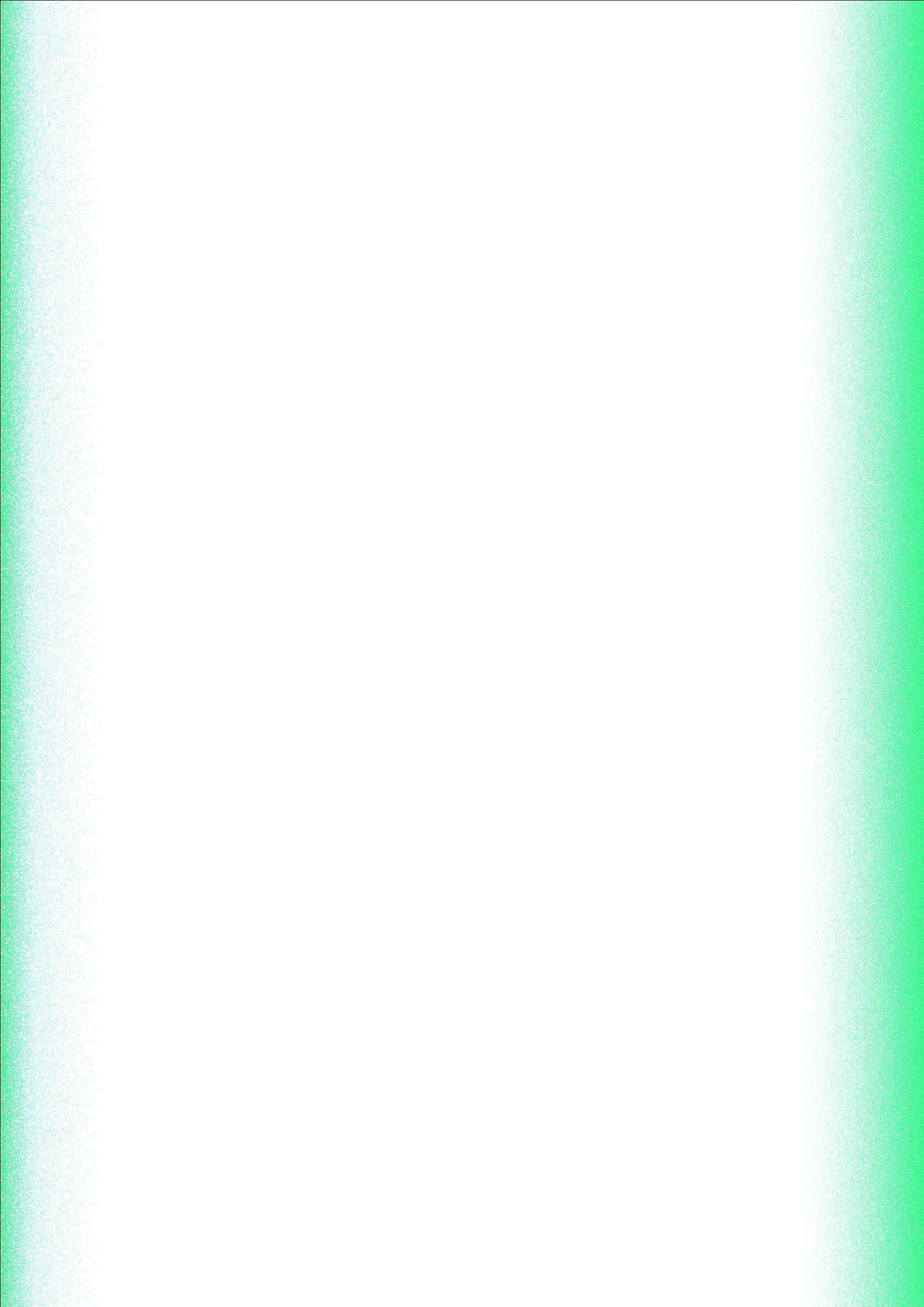
‘I’ve discovered this humming’, Francesca Bogani Amadori
Museum Property, Lotta Hagelin
‘One plus one becomes three’, Impropias Collective
‘Trying not to build walls’, Eliisa Suvanto
‘From us to us’, Alice Mutoni
Contents
1 25 41 47 67 89
‘In this mulch of voices something can hatch’, Lucy Davis
‘Heads on a shared stomach’, Naomi and Wanda Holopainen
Subcontinental Helsinki, Muniba Rasheed
‘Tactile connection’, Alejandra Alarcón
A Resistance Against Abundant Comfort, Amy Gelera

Lù Chén on design
105 123 139 147 167 179
Nooks, Threshold, and Highways
 Micol Curatolo
Micol Curatolo
1

Micol Curatolo is a cultural worker in the feld of contemporary art. Her research refects on everyday borders, belonging and geography. Using border thinking, Micol investigates how arts and culture negotiate identity, participation, and experiences of migration. Micol works with multi-vocal and everyday formats. She is interested in creative work that addresses people's stories, their possible conficts and their common emotions.
2
Here, Not. is a project about closeness.
Here, as in the tram line connecting your fat to mine, to the sea, to the university; connecting the cultural centre to the hospital, your place of work, the Parliament House. Here, as in Helsinki, Finland. Here, where we have moved from elsewhere and where for some time we’ll stay. Here, yours at times and at times not.
Here, Not. investigates how people express identity and belonging through contemporary art in the urban spaces of Helsinki.
‘Border thinking’ is the methodology behind the book.
A border is a device controlled to let some-thing and someone cross, deciding if they can enter or exit a territory and, by that choice, controlling where they can exist. Tose who cross undergo a transformation: value is accrued or lost, identity is assigned, new duties and roles are imposed.
Tinking about and with borders implies that we pay attention to all the border lines operating in our
3
environments and actions. Border thinking points to the everyday borders that modulate the regimes of visibility –that is, who and what is present and recognised – through which we construct the places we inhabit. Border thinking can help us refect on how cultural work participates, every day, in the global and local dynamics through which we produce geographies that are accessible, safe, and home for some and not for others.
In the book, these refections develop together with fourteen arts and cultural workers based in Helsinki. Teir ten contributions focus on what is happening across and beyond the threshold of the art gallery and how art sits and is bridged into the city.
To visualise these dynamics, we can play with three elements: — lines; — movement along, across, and on these lines; — the sites produced by those lines and the people and art moving along them.
Su cuerpo es una bocacalle.
1 Her body is the crossroads.
4
is a site of negotiation. A threshold.
‘…every word, every syllable I utter comes from a riot within my mouth. It is a babel between subconscious, tongue, teeth and vocal cords ...
See, this speech comes from a slaughterhouse I call my mouth.
See, this mouth is a battlefeld, a clash of unyielding cultures warring for dominance.
See, my tongue is a traumatized survivor lost in an alien fuency.
See, this accent is how I fnd my way home…’2
Relocating triggers a communication lag: you shout I am here, and the cavities of your own body, in an unexpected unison with the fords of this new place, echo back I am not.
5
uth
Your m
Urban environments are flled with noise but unbothered in words.
C’è una terra che tace e non è terra tua.3
Tere’s a land keeping silent and that land isn’t yours.
‘Ewú shoduwè?
It’s about time you learn my language too.’ 4
Bodies can actively ‘unbelong’ to reclaim presence.5 It is a power play with the ability to go un-seen.
Here is the problem and the answer. Here, at the tensive hyphen between un—seen.
Te —, that’s the line we are going to follow.
Te gasp, the crack, the pause, the act of pulling apart in order to keep together.
Te erasure of some(things), made invisible, which reinforces the visibility of others. It is along these hyphens that we become complicit.
6
Here, Not. tries to stand on them. It considers the line in relation to movement not simply as a trace of direction but as a place to linger on: a viewing platform in motion.
My curatorial research follows the way artworks and moving people travel and are present, tracing and reconfguring the city and its spaces for culture. ‘Tese cartographies of collective life […] frame a sense of what
7Art curating: the practice that coordinates, imagines, and arranges the material, intellectual, aesthetic, and personal interactions between disparate artistic works, practices, and practitioners to create a collective result (exhibition, event, public programme, etc) and communicate its framework with the audience. Curating is part of a broader teamwork of technicians, designers, educators, historians, artists, and experts in diferent felds. is possible.’6 Migration, belonging, home, memory, comfort, public expressions of afection and identity, participation, gender, and collective work. Art curating7 can ask questions to itself and others by following movement:
‘Te question of what diversity does is also, then, a question of where diversity goes (and where it does not), as well as in whom and in what diversity is deposited (as well as in whom or in what it is not).’8
To be honest, Here, Not. is especially a project about unresolved questions and scavenging for where they lead. Here, as in where my practice develops towards and how it
7
gets there. Why me? And if me, how? Not, as in doing the work to notice and unlearn my own complicity.
Nooks
Te word environment indicates the material network between a place and all the beings that make that place. Te environment is about profound physical enmeshment. Space and place, accordingly, are never abstract nor empty.9 Place is a complication of space. Place suggests the making of cultural and symbolic layers with a site. In reverse, making place happens as material, cultural and symbolic relations are threaded with a site to create its communal living. Anthropologist Tim Ingold describes place as a knot: the lively reality produced by the interdependent relations between diverse agents in motion and their home.
‘... human existence is not fundamentally place-bound, as Christopher Tilley (2004: 25) maintains, but place-binding. It unfolds not in places but along paths. Proceeding along a path, every inhabitant lays a trail. Where
8
Te production of Here is a work of meaning-making that takes place along trajectories. Tese create nooks: the triangulation of a couple of livelihoods interacting within the larger site. A nook, we can imagine it, is a busy relational place with blurry borders to its surroundings.
To me, this image works well to defne what happens around arts and culture, too. Cultural workers, artworks, and audiences together create a nook of sorts: a triangulation of their actions threading a new placemaking while inevitably interacting with the framework that the site itself carries. I want to think about the contemporary art exhibition as one such place where art workers and visitors are tightly knotted together in the act of fulflling their roles, but also by the extension of their lives into inhabitants meet, trails are entwined, as the life of each becomes bound up with the other. [...] Places, then, are like knots, and the threads from which they are tied are lines of wayfaring. A house, for example, is a place where the lines of its residents are tightly knotted together.’10
9
Meshwork—Patchwork—Homework—Linework— Bodywork—Work
the space. Feminism of Colour and intersectional theory11 unravel the ways in which ‘a body can be a meeting point,’ a place-making knot of its own kind.12 Tis opens a door to noticing how the presence of certain bodies in the urban environment leaks into the space of the art exhibition, too.
Let’s come back to border thinking.
Bordering
As borders become increasingly ‘mobile, portable, omnipresent, and ubiquitous realities [...] to be alive, or to survive, is more and more co-terminus with the capacity to move.’13 Political theorist Achille Mbembe calls borderization the practice of multiplying borders to control and strengthen geographical divisions across diferent scales of place. Tis is a process of space modifcation: from nation-state borders to local communities or private buildings, bordering devices are designed and policed to control who can enter and who can leave. Everyone and everything is assigned a certain capacity of crossing.
Te impossibility of entering or staying in a site does not end within itself: it assigns racial defnitions to those who cannot cross, becoming endangered along multiple and disseminated lines.14 Tese are kinopolitics – politics of movement. Borderization draws a geography
10
Te mobility of a person racialised under the infrastructures of white supremacy is exponentially more controlled than those who hold privilege within the same infrastructures. A large legacy of BIPOC authors, artists, and thinkers15 has documented how racialised that exacerbates exclusion based on value and race. Borderization repeatedly cuts people out of place. border cesura a midline pause imposed on your thinking, severing the fow. Losing meaning.
15BIPOC: Black, Indigenous, People of Colour. Some authors working with the themes of this book are Frantz Fanon, Audre Lorde, Gloria E. Anzaldúa, Homi K. Bhabha, Irit Rogof, Ana Mendieta, among others. livelihoods are erased from the public sphere by forced marginalisation, exactly by preventing the racialised body from entering, inhabiting, and expressing in the public environment.15 Simultaneously, the racialised person becomes hypervisible and hyper-present. In Frantz Fanon’s Black Skin, White Masks (1952):
‘A
triple persona, [...] three places, [...] I existed triply: I occupied
11
space. I moved toward the other [...] the evanescent other, hostile but not opaque, transparent, not there, disappeared. Nausea ... I was responsible at the same time for my body, for my race, for my ancestors. I discovered my blackness [...] My body was given back to me sprawled out, distorted, recolored, clad in mourning on that white winter day.’16
Bordering becomes habitual to the point of going unnoticed; ‘this is why when we attend to intersectionality we are actually making a point,’ scholar Sara Ahmed writes that ‘there is labor in attending to what recedes from view.’17
Let’s talk about transparency then.
Tim Ingold ofers the example of a carpenter who, hammering, pays real attention to the hammer only when the tool does not work as desired.18 Similarly, artist Antoni Gaudì notes that a design is noticed only when it does not function as wanted.19 In other words, devices are considered malfunctioning when the interaction isn’t easy enough to go unnoticed. Gaudì moulded a door handle into his hand so it could disappear in the perception of a body similar to his own.
Te form Western society gives to the world, with its
12
functionality, is moulded to the man. If things (and people) are labelled as functioning (or not), right (or not), when they are smooth(less) to one person, who is the mould?
Thresholds
A door ajar20 opened by a handle moulded in your palm.
Let’s set one foot in the art gallery and the other on the city street: standing across the threshold, our view is split by the doorframe.
On both sides, you’ll fnd a culturally loaded environment that can host potential nooks for speculative, idealistic, brutal, and sof, temporarily knotted worlds. Tis art-nook is a place where we can feel safe to test and try out, where the collective work of making culture turns us into one industrious dis-jointed body; but let’s not hide in our nook for too long. Taking over a space, it is on us to decide how permeable its doors will become and for whom.
‘Saying I don’t know is a start. What then if we hear I don’t know not as a declaration of ignorance but rather as an appeal for intimacy? [...] Intimacy
13
leaves doors ajar to encounters that might be difcult, messy. [...] As the door ajar can induce encounters based on trust and risk; it acknowledges that there cannot be trust without risk, and vice versa. [...] A door ajar does not mean that one has the right to enter, but it ofers an invitation to stand at the threshold and knock.’21
A door is constituent to the space but also somewhat out of it. Te door is an afordance, where value and meaning are discovered in the process of use, but also a site where they ‘can be directly perceived.’22 Te door functions as a mouth: a point of entrance, negotiation, decision-making, a place of exploration, and intimacy. Half private, half public.
Te interesting thing about doors is that they develop in a certain (horizontal) direction while they let movement happen orthogonally across. At the crossroads of these directions, one can actually stand still. If one inhabits a point along a line of travel, here, time pauses and enlarges. Te quick communication that the door invites is then embodied and expanded, catalysed and shredded by the body who decides to sit on that threshold and express in movement and words, to become a bridge.
Architect and activist Stavros Stavrides calls thresholds the in-between places, the passages built when people
14
attempt to create an ‘emancipatory spaciality’ and develop border consciousness.23 Tis happens when people decide to meet each other through the struggle of recognising diferences and addressing personal change. It is a painful, confictual process because it requires crossing internal borders upheld for safety, to encounter the boundaries of another’s livelihood. Tere is no romanticism here; rather a reminder that only through experiences of contact and self-recognition one unlearns phobias – xenophobia, transphobia, homophobia, etc. – which trap both the othered and the othering in the gaps of our knowledge where narratives of danger have overgrown. For this, thresholds can only be made collectively: ‘A type of collaboration where you try to let everyone work in ways that are individually right for them. [...] A group becomes a collective when they make a conscious decision and choose to see each other as equals.’24 To build thresholds, we need a (un)learning crowd in motion.
Here, Not. plays with the communication and engagement created by such attempts to inhabit and settle at the door; with what the door can do to bodies who use it for transitioning rather than travel.
15
Highways
A line of travel is other than a line of movement. Movement inhabits place. In movement, one makes sense of the world and continuously produces knowledge with reality’s shapeshifing. Instead, a line of travel moves between two points less to understand than to arrive.
Standing at the tram stop, the overhead wires tangle above our heads. We await to be picked up. Sit and move. Drop of – it is a new place we are in.
Knowledge is relational, experiential, temporal and creative. Information is quick, set, analytical and synthetic. Travel takes away the ‘all-around perception’ by which one notices others.25 As one loses the habit of producing knowledge ecologically, one wants to travel faster. Here we are: ‘emplacement becomes enclosure, travelling becomes transport, and ways of knowing become transmitted culture.’26
I N V E R S I O N
‘To be alive, or to remain alive, is increasingly tantamount to being able to move speedily.’27
T R A P
16
My thoughts are rushing again. How does one slow down without ceasing to move? How does one make art without becoming elitist?
COUNTERSPACE’s ‘folded architectures’ come to mind: art publications which become ‘a sandwich wrapper, a falafel house shop-window poster, a tablecloth in the central market for ifar.’28 I want to make events that are as visceral to people’s lives as the breakfast blanket they eat porridge on in the morning; artefacts you can carry in your pocket next to a pack of mints; exhibitions that enter our lives as another one of the things we feed ourselves with.
Remember Ingold’s upset carpenter and Gaudì’s bodily handle?
‘Humans alone are haunted by the spectre of the loss of meaning that occurs when action fails;’ humans imagine reality by ‘the occasional glimpses of a world rendered meaningless by its dissociation from action.’29
Let art be something that moves and disappears and carries us away.
17
What I am chasing afer as a cultural worker are the zones where we can catch as many glimpses of our world rendered for a moment meaningless to ourselves but meaningful to others. Here, Not. is chasing for fractures where reality enlarges onto the world of someone/something else. Moving to explore, to train the eye, and to tackle our biases and fears. To see the many worlds overlaid on our shared spaces. Let’s follow movement to ask questions, notice closeness, and see complicity. Here, I will stand on the line of those questions, at the door of a gallery, on the threshold of my fellow art workers’ practices, and open myself to conversations that can hint at where to go.
Dialogues
Access to movement means access to culture and a choice over how to participate. Curator Carla Gimeno Jaria says that the role of the curator at the borders involves ‘the development of patterns of hospitality, by providing the spatio-temporal conditions to engender encounters between unknown entities or bodies.’30 I will hold that curating should always, not only at the borders, be an extended and temporal efort to negotiate and open encounters. Tis is another reason why border thinking is important and efcient around any border, starting with a door: to work collectively on ‘what kind of citizenship is
18
aforded’ by cultural workers and audiences in the urban and artistic space of Here.31
In the spirit of border thinking, I have invited fourteen Helsinki-based artists, designers, and cultural workers to be in conversation around their practices. Dancing or cooking together, in their studio or a greenhouse, I have tried to break away from the formal dynamic between curator-artist and interviewer-interviewee. I hope this resonates in the contributions: seven conversations, two photographic series, and an opinion piece, beautifully designed by Lù. Meeting these people and their practices has ofered moments of discovery, pleasure, and refection. It has helped me navigate the beginning of my career and my being in Finland. Tey all work on participation, accessibility, and geography, cultivating larger, multidisciplinary, and inclusive defnitions of arts and art spaces in Helsinki’s cultural scene.
‘I’ve discovered this humming’ is a conversation with artist Francesca Bogani Amadori, whose work overlays the rhythms of Lima, Perù and Helsinki, Finland, in multimedia archives of walks and feld recordings. Together, we refect on safety, visibility, and policing in public urban spaces.
Lotta Hagelin presents Museum Property (2023). Te photographs capture a tension between stillness and motion that tells about the objectifcation that Sámi people and culture have
19
sufered by the Nordic nation states, it portrays the endurance and activism of Sámi youth, and echoes the repatriation of Sámi heritage from the Finnish National Museum to the Sámi Museum Siida.
Impropias Collective discuss the power, awkwardness, and joy of dancing with strangers as a social practice, when ‘One plus one becomes three’ and dance recalibrates interactions. Daniela, Mercedes, Paola, and Yes connect music, urban rhythms, and memory to deal with how bodies move in the built environment, partying to Latin-American tunes.
Curator-producer Eliisa Suvanto shares about the values embedded in their collective work with Porin kulttuurisäätö, the bureaucracy of accessing public spaces in Finland, and the conversations hosted by site-specifc public art, stubbornly and purposefully ‘Trying not to build walls’.
‘From us to us’ is a conversation with Alice Mutoni, one of the three founders of Ubuntu Film Club. With their free documentary screenings, Alice, Rewina and Fiona have created a low-threshold space for BIPOC youth and friends to learn and talk about contemporary issues while having fun and catalysing a sense of excitement and belonging.
20
Visual artist Lucy Davis tells about the process of narrating a place and its entwinements with nature, politics, urban planning, and migration. ‘In this mulch of voices something can hatch’ discusses the politics of representation of the human and more-than-human community living in Tanglin Halt, Singapore.
Naomi and Wanda Holopainen refect on how we can shif the narratives around diversity, representation, and power in the creative industry from artistic production to collective work, education, and marketing. Naomi, Wanda, and I talk about fulflling one’s social responsibility through creative work.
Muniba Rasheed presents Subcontinental Helsinki (2023), a research into the use of typefaces by Helsinki’s Indian, Pakistani, and Nepalese restaurants to portray and convey cultural genuinity and identity. Muniba’s photographic documentation of the shopfronts mirrors how ethnic presence is self-marketed in everyday urban spaces.
In ‘Tactile connection’, designer Alejandra Alarcón and I discuss food as a contemporary design practice. While preparing salsa, Alejandra shares about cooking as a space of encounter with our surroundings. We refect on how favours and food consumption deal with traditions,
21
belonging, pride, and self-sustenance.
Amy Gelera’s bittersweet A Resistance Against Abundant Comfort seals the refections of this book around migration, the search for comfort “back home” and in one’s “new home”, and the complicity and contradictions of our practices. Amy calls out the shortcomings of Finnish educational institutions and social welfare and, with kind and sharp realism, they propose motion as a form of resistance and discomfort as an act of responsibility.
22
1. Gloria E. Anzaldúa, Borderlands: the new mestiza = La frontera (San Francisco: Spinsters/Aunt Lute, 1987), 80.
2. Havfy (Hafsat Abdullahi), ‘To the girl in English class’, YoutTube, 2022, (https://www.youtube.com/watch?v=T2oJ5bk34-M&ab_ channel=Havfy).
3. Cesare Pavese, Verrà la morte e avrà i tuoi occhi (Torino: Guilio Einaudi Editore, 1951), 13.
4. Havfy, 2022.
5. Irit Rogof, Terra Infrma: geography’s visual culture (London: Routledge, 2022), 5.
6. Catalin Gheorghe and Mick Wilson, ‘Introduction’, Exhibitionary Acts of Political Imagination, ed. Mick Wilson and Catalin Gheorghe (Gothenburg: PARSE, Iasi: Vector, 2021), 8.
7. Art curating: the practice that coordinates, imagines, and arranges the material, intellectual, aesthetic, and personal interactions between disparate artistic works, practices, and practitioners to create a collective result (exhibition, event, public programme, etc) and communicate its framework with the audience. Curating is part of a broader teamwork of technicians, designers, educators, historians, artists, and experts in diferent felds.
8. Sara Ahmed, On Being Included: Racism and Diversity in Institutional Life (Durham, NC and London: Duke University Press, 2012), 12.
9. Doreen B. Massey, For Space (United Kingdom: SAGE Publications, 2005), 6.
10. Tim Ingold, Being Alive: Essays on Movement, Knowledge and Description (United Kingdom: Taylor & Francis, 2011), 148.
11. Kimberle Crenshaw, ‘Mapping the Margins: Intersectionality, Identity Politics, and Violence against Women of Color’, Stanford Law Review 43, 6 (1991), 1241–99.
12. Ahmed 2012, 14.
13. Achille Mbembe, ‘Bodies as borders’, From the European South 4 (2019), 9-10.
14. Ibid.
15. BIPOC: Black, Indigenous, People of Colour. References on the themes of the book are by Frantz Fanon, Audre Lorde, Gloria Anzaldúa, Homi K. Bhabha, Irit Rogof, Ana Mendieta, among others.
23
16. Frantz Fanon, Black Skin, White Masks (United Kingdom: Pluto Press, 2008), 259.
17. Ahmed 2012, 14.
18. Ingold 2021, 81.
19. Museu Nacional d'Art de Catalunya, Barcelona, ‘Door handle for Casa Milà ('La Pedrera'), model 1’ (https://www.museunacional. cat/en/colleccio/door-handle-casa-mila-la-pedrera-model-1/ antoni-gaudi/214667-000).
20. Eloise Sweetman, Curatorial Feelings, ed. E. Sweetman and J. Tang (Rotterdam: Shimmer Press, 2021), 33-40.
21. Ibid.
22. Ingold 2021, 78.
23. Stavros Stavrides, Towards the City of Tresholds (United States: Common Notions, 2019), 27-36.
24. Index Teen Advisory Board and PRAKSIS Teen Advisory Board, How do we know? Institutional Listening and Young Agency in the Arts (Oslo: PRAKSIS, Stockholm: Index Foundation, Helsinki: PUBLICS, 2022), 14.
25. Ingold 2021, 145.
26. Ibid.
27. Mbembe 2019, 8.
28. COUNTERSPACE Studio, ‘Material Histories’ (https://www. counterspace-studio.com/projects/material-histories/).
29. Ingold 2021, 81.
30. Carla Gimeno Jaria, ‘What Borders Can Do’, Oncurating, ed. Hadas Kedar, 50 (2021), 91-99 (https://on-curating.org/issue-50reader/what-borders-can-do.html#.ZHXtuXYza3A).
31. Mick Wilson and Cosmin Costinaș, ‘Te Space of the exhibition as a space of political potential: a conversation with Cosmin Costinaș’, Exhibitionary Acts of Political Imagination, ed. Mick Wilson and Catalin Gheorghe (Gothenburg: PARSE and Iasi: Vector, 2021), 37.
24
I’ve discovered this humming
 Francesca Bogani Amadori
Francesca Bogani Amadori
25

Francesca Bogani Amadori is a visual artist and artistic researcher based in Helsinki. Teir work looks at the (inter)dependent relation of subjects and spaces within geopolitical and sociocultural hegemonic systems. Bogani Amadori draws on the personal experience of dealing with (in)visible power dynamics through performance, walking, (re)mapping, and active listening. As a means of resistance, their diverse process-based practice focuses on attunement, being porous, volatile, and shifing by engaging in multiple directionalities and intensities. Teir work unfolds as audiovisual installations, video, photography, soundscapes, sound walks, experimental and academic writing.

On April 11, 2023, Francesca and I practised a soundrecording walk in the neighbourhood of Töölö, Helsinki, where we both have lived at diferent times. I led the walk, letting the surroundings guide my movement. Francesca followed 2 metres behind, recording the soundscape. Tis conversation took place in my fat afer the walk.
26
Francesca (F) Micol (M)
F: When we were walking together and I followed you, recording the sounds, whatever I did was double the size. Me, and you, too. It was like I had an extension, like my body was longer. It was interesting because, as the walk continued, it almost became a question of trust.
M: I was guiding you into my way of seeing the city.
F: It became quite intimate. When you share an experience, you always add a layer to your thinking. It's interesting also that, as I try to draw a map of the frst part of our walk, I have a big gap ... I’m clueless.
M: Why is that?
F: Because I was trying to be invisible. Since I was mimicking you or dealing with your way of navigating the city, the movement didn’t come from me. Now I’m trying to remember, rather than having it from within.
27
M: Does it happen also when you do soundwalks by yourself?
F: Not really… It is by default that our body circulates in a certain way.
M: I was making choices, defnitely. At one point, it felt like I was trying to chase away from things rather than moving forwards. I was trying to get to quieter places.
F: Exactly. When I moved here, I perceived the city as silent. But when I started recording and walking, I discovered this humming: a lot of this “mhhh”, a lot of ... not, white noise ... but a lot of “kchukchukchu”, and soooo many engines.
M: It’s a body that moves, the city. I mean, comparing cities to bodies is quite common, but Helsinki really makes its own sound.
F: It isn’t people – it’s these machines.
M: As if it had joints that crack.
28
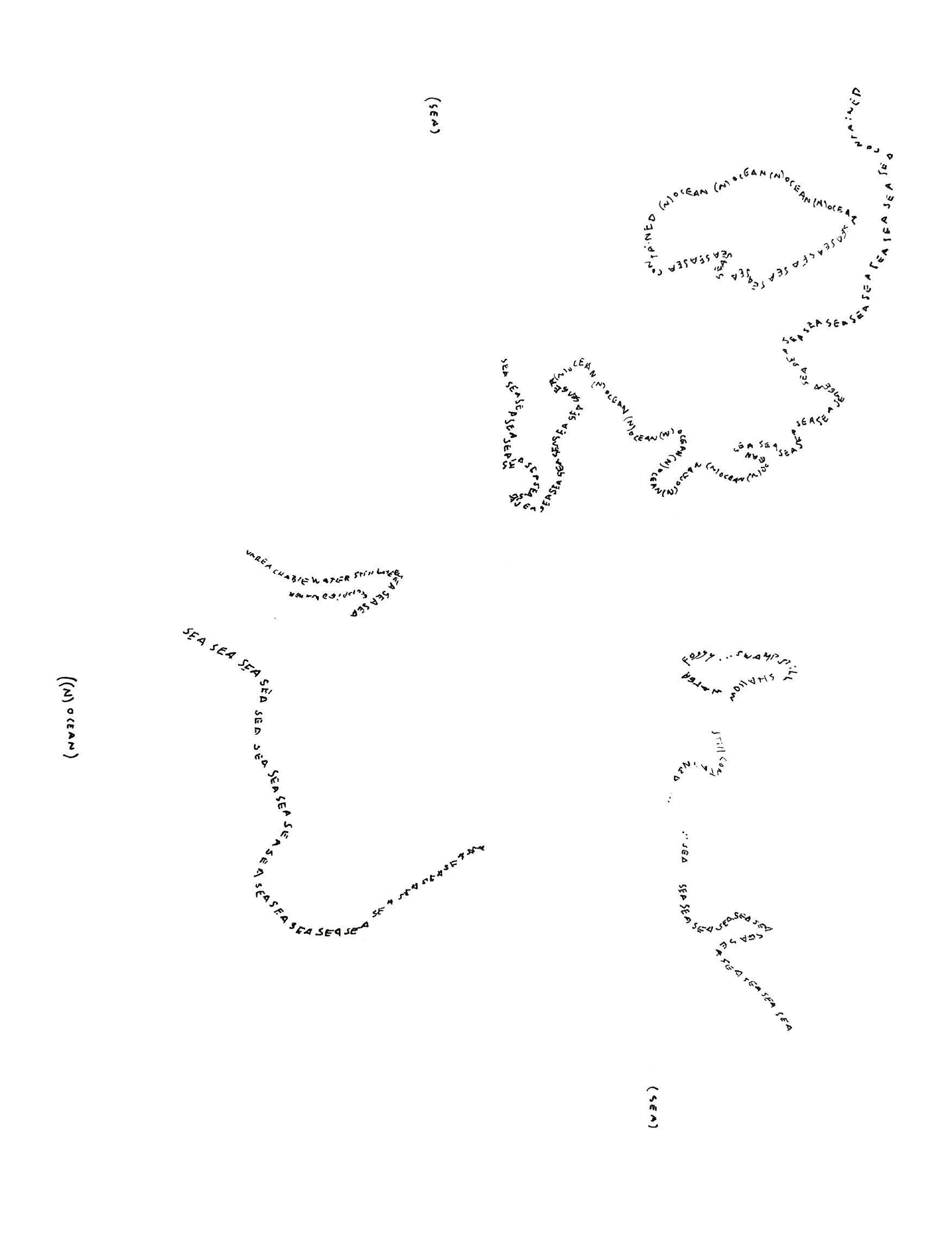
Francesca Bogani Amadori, Tracing (n)ocean.
Walk-Listening mapping practice, 2023, Helsinki. Digitalized maps, variable dimensions.
M: Should we try to draw the map? ... Now I’m confused. I think Helsinki looked a bit diferent today. I don’t know, maybe it’s the season.
F: Seasons afect a lot. Te thing with the summer is performativity. Summer grants you permission to be outside doing nothing; you are allowed to wander, to just lay on the ground. You’re allowed to be.
M: Today, I felt like a visitor. One could hear so much: the trains and the trams on the farthest horizon. Listening, I could hear these nodes of movement which the city is organised around. Afer two years, I still sense that it isn’t mine, the city. I’m not uncomfortable, I don’t feel out of place, but I still relive the experience of seeing Helsinki for the frst time. Tere’s something almost reassuring knowing that, when I need a break, I can go out and perceive the city as if it doesn’t quite belong to me. To be honest, it almost doesn’t belong to anyone. Do you know what I mean?
F: Yes, it’s hard to make the outside yours, because the public is also always privatised. It’s transitory. And everything else is enclosed: all your livelihood is within.
M: Would you say that this is diferent in Lima?
30
F: Te city is more hostile, defnitely more chaotic. But the spaces feel more taken by the public. I couldn’t walk safely or at ease in many places in Lima. So when I came to Helsinki, I was “Oh, walking!” Tat changed my perception of here and the scale of here. Navigating the city of Lima was most likely by car. Somehow, here, the city feels so tiny that I feel like falling out of its edges. While there, walking, the city would feel massive. Lacking the car and walking in Helsinki has made me perceive space on another scale. I rely more on my own size.
M: Is the way you look more visible in Helsinki?
F: Well, certain bodies gather diferent types of attention than others. In Lima, one comes across many intentions; you know, catcalling, angry glares that might indicate a risk ... People in the daily context are defensive. You receive neutral stares or random smiles, some intruding, some sympathetic. Here is diferent. Tere are other sorts of microaggressions or gazes. It’s the other side of the coin. Yet, at the same time, I’m invisible here. I don’t know if that’s better or worse, but I’ve been playing with that. I don’t think I would have managed to become invisible at home. Here, sound recording has allowed me to be in places more easily because it grants me an occupation.
31
F: One day, I was walking for a whole hour in Kamppi station. Walking and walking and walking. I knew someone was going to come. Tey came. But it took a while; it took an hour.
M: Te security came?
F: Yes, of course. But it took one hour, and I was questioning: if I had looked diferently, how long would it have taken? Before that, they approached other people. Way earlier. Tey were just sitting around; while I was walking in circles and coming up and down the escalator for a whole hour. One hour later, they came.
M: It’s a question of when we become accessible to others ... Te street holds a diferent status.
F: For that reason, at frst, it was hard to be outside, walk, and stroll. Right now, I’m not making dérive work1. I’m walking with the purpose of understanding myself in this space, but even that is privileged.
1Dérive (French “drift”) is a practice of walking in the urban environment established in the 1950s by the Situationist movement and formulated in Guy Debord’s Theory of the Dérive (1958). Practising la dérive, one wanders through the city being guided by emotions and personal experiences connected to the space (Psychogeography) rather than by functional, productive, or normative logics.
32
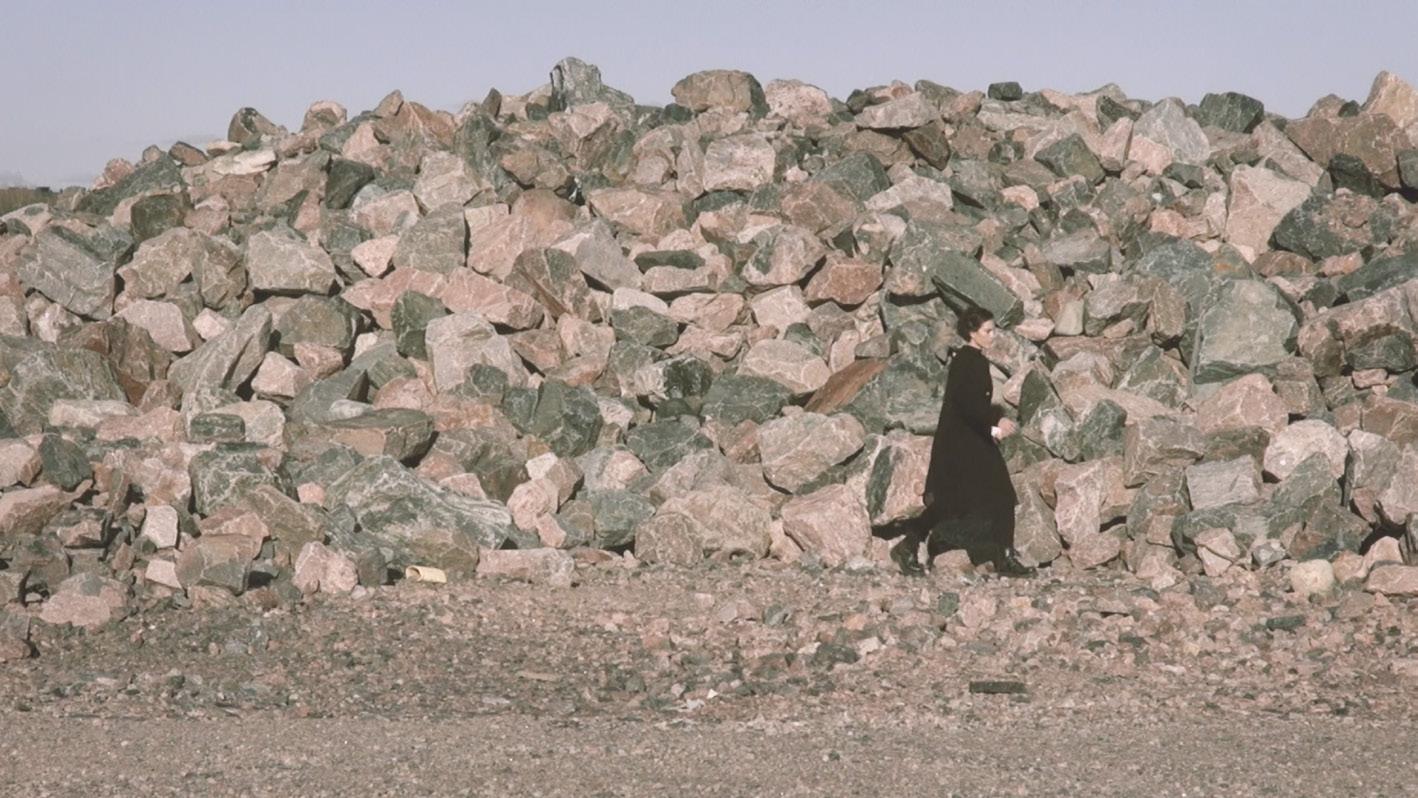
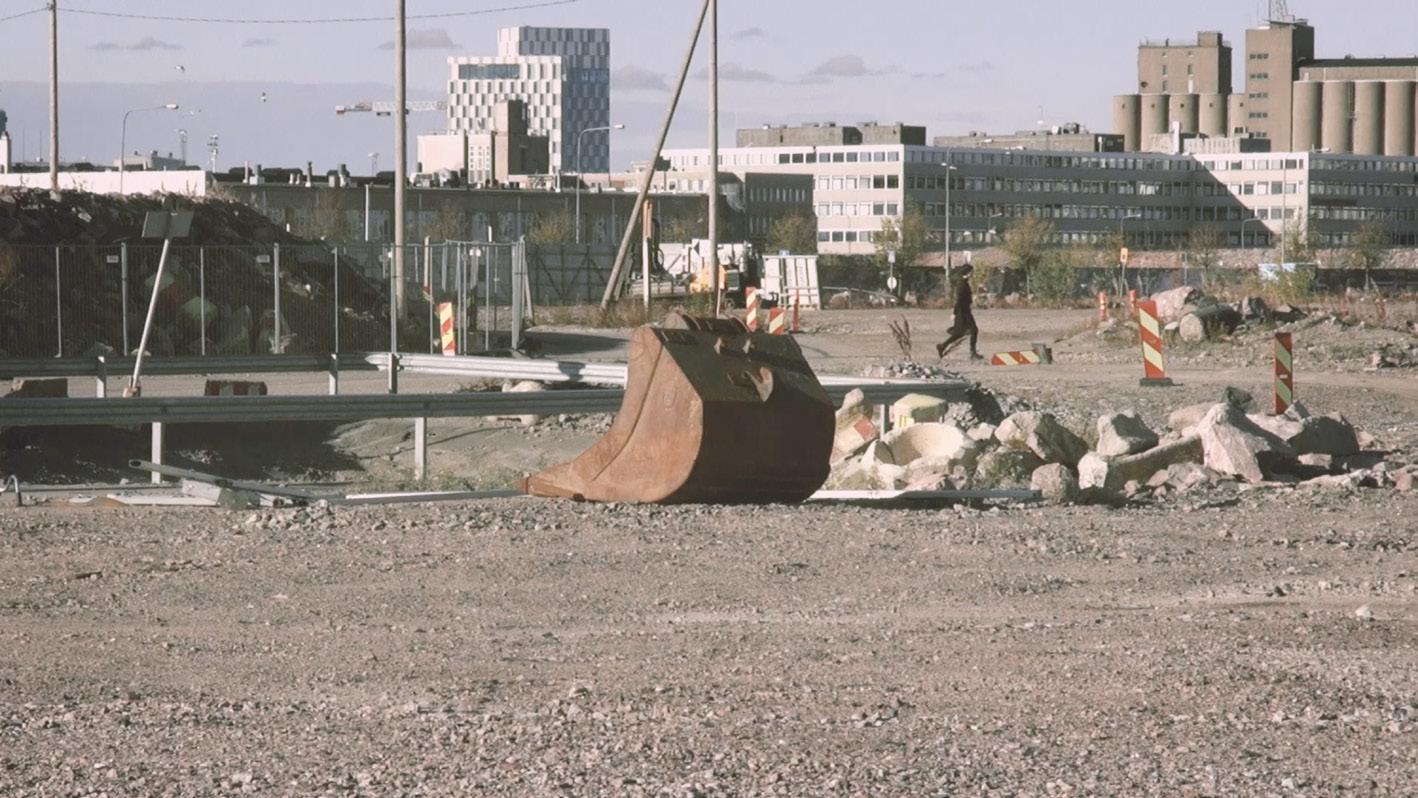
33


and modular audio.
34
Francesca Bogani Amadori, Making-here: Embodied Memory. Walk performance, 2022, Helsinki. Video documentation: Henry Lämsä. Post-production by Francesca Bogani Amadori. Field recordings in Lima and Helsinki (2022 - 2023)
M: Have you ever tried to be still in a place?
F: Tat isn’t for me, I think.
[Francesca laughs.]
M: When we walked past the playground, I was thinking about how we as a society need to make a place where one’s allowed to stay and do nothing ... Well, playing isn’t “doing nothing”, but you know what I mean ... Tere, you’re allowed to linger.
Why is walking easier for you?
F: It helps me think, and it unlocks things that are carried in my body. It was hard for me today to walk at a diferent pace – yours – because I still carry this memory of how to walk in a faster city. I still have this defensive mode ... Tat’s why I walk: because I untangle a lot of “back home” and this “new home”. It needs to be in the space, by walking rather than just sitting. I’ve been playing with that in terms of making home.
M: How does it feel to “feel at home”?
F: Sometimes, it’s a made-up feeling. I can look for the elements that, in my memory, remind me of home: water and wind. Sometimes, it’s when I don’t notice what I’m doing; whenever things just happen or the city disappears. Like breathing! Sometimes, being noticed makes me
35
realise I’m not at home; sometimes, being too invisible makes me realise I’m not at home.
M: Do you feel at home in Lima?
F: Here in Helsinki, I feel at home on a bigger spectrum in the sense that I can be in the extension of a city, whereas there I cannot. I feel limited. In Lima, I inhabit areas; most of them are private. So my idea of the city is narrowed down to specifc districts. Access to what I’m doing right now, like recording soundscapes, would have to be mostly in private areas for safety reasons. I cannot cover as much space. Maybe not knowing, not being aware of certain layers, is granting me this “security” here. So far, being an outsider has allowed me to, at least, reach further than I would have been able back at home. Probably, being an outsider there would have gotten me in trouble.
M: Do you think that the moment will come when you would feel not an outsider?
F: No. Do you?
M: I don’t know. Right now, my life travels on a parallel layer of relations that I’ve imposed above the city.
F: I get that.
36
M: It is a strange position to be in.
F: A superfcial fow, like smoke. I thought I wasn’t in this transit mode anymore, but I think I still am. I’m still foating; I’m not rooting.
M: Floating is a good image. One is allowed to build this foating platform that stands above the centre. Of course, this is already a privilege.
F: Tat’s the thing: there is the possibility of being invisible, if you want, by having this extra layer. At some point, I was playing with that, and then I said, “No.”
Francesca Bogani Amadori, Un/tangled mapping horizons. Walk-Listening mapping practice, 2022, Helsinki. Mixed media collage, variable dimensions. ^
37
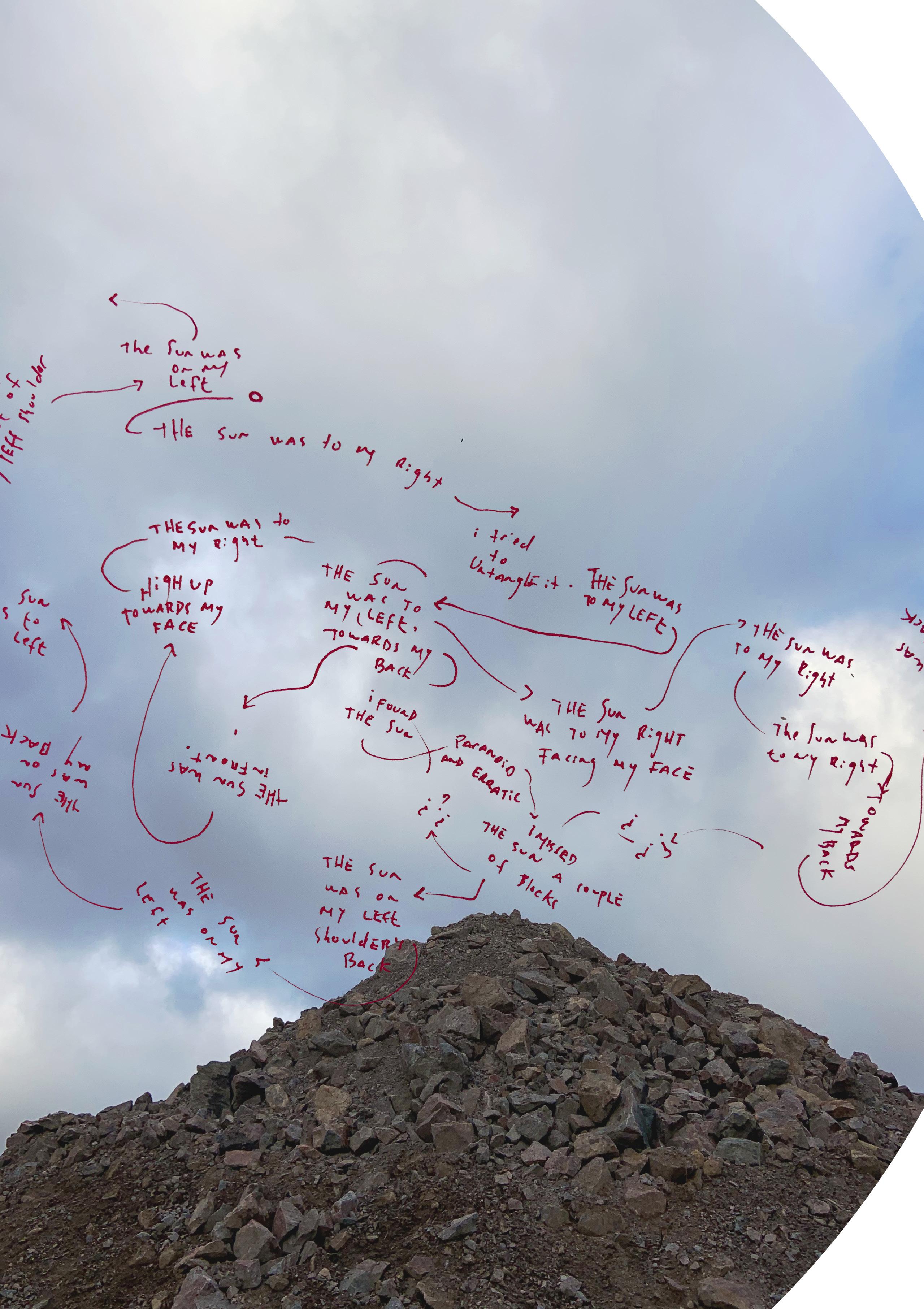
1. Dérive (French “drif”) is a practice of walking in the urban environment established in the 1950s by the Situationist movement and formulated in Guy Debord’s Teory of the Dérive (1958). Practising la dérive, one wanders through the city being guided by emotions and personal experiences connected to the space (Psychogeography) rather than by functional, productive, or normative logics.
39
40
Museum Property
Lotta Hagelin

Lotta Hagelin is currently studying Visual Communication Design at Aalto University and has a Bachelor’s degree in Arts. Her work focuses on issues related to the Sámi people by being active at the street level, participating in Sámi organisations, and providing an indigenous voice to the youth-led NGO Operaatio Arktis.
41
Lotta:

Museum Property (2023) is a collection of works about the feeling of putting on a gákti, Sámi dress, in the urban environment. Just wearing a gákti in the streets brings a sense of forced performance. One is being observed, photographed, stared at – as if we were museum objects. With this project, I have wanted to create a moment when we can face these gazes on our own terms. To explore the unpleasant feeling together and examine how we, even when being objectifed, could be in control of that dynamic.
As the Finnish National Museum has provided the museum equipment for this project, with my work, I want to take a stand on the politics of museums in relation to the possession of Sámi objects and the representation of the Sámi and Sámi culture created by art institutions. Although the Finnish National Museum has a history of possessing Sámi property, today, the museum has been a major player in contributing to the Sámi people’s right to their own cultural heritage and is leading the way in the global repatriation discourse as it has completed the repatriation process and handed over its Sámi collection to the Sámi Museum Siida in Inari, Sápmi.
42

Lotta Hagelin, Aarni, Seen, series ‘Museum Property’, 2023, digital photograph.
 Lotta Hagelin, Biret-Iŋgá, Noticed, series ‘Museum Property’, 2023, digital photograph.
Lotta Hagelin, Biret-Iŋgá, Noticed, series ‘Museum Property’, 2023, digital photograph.
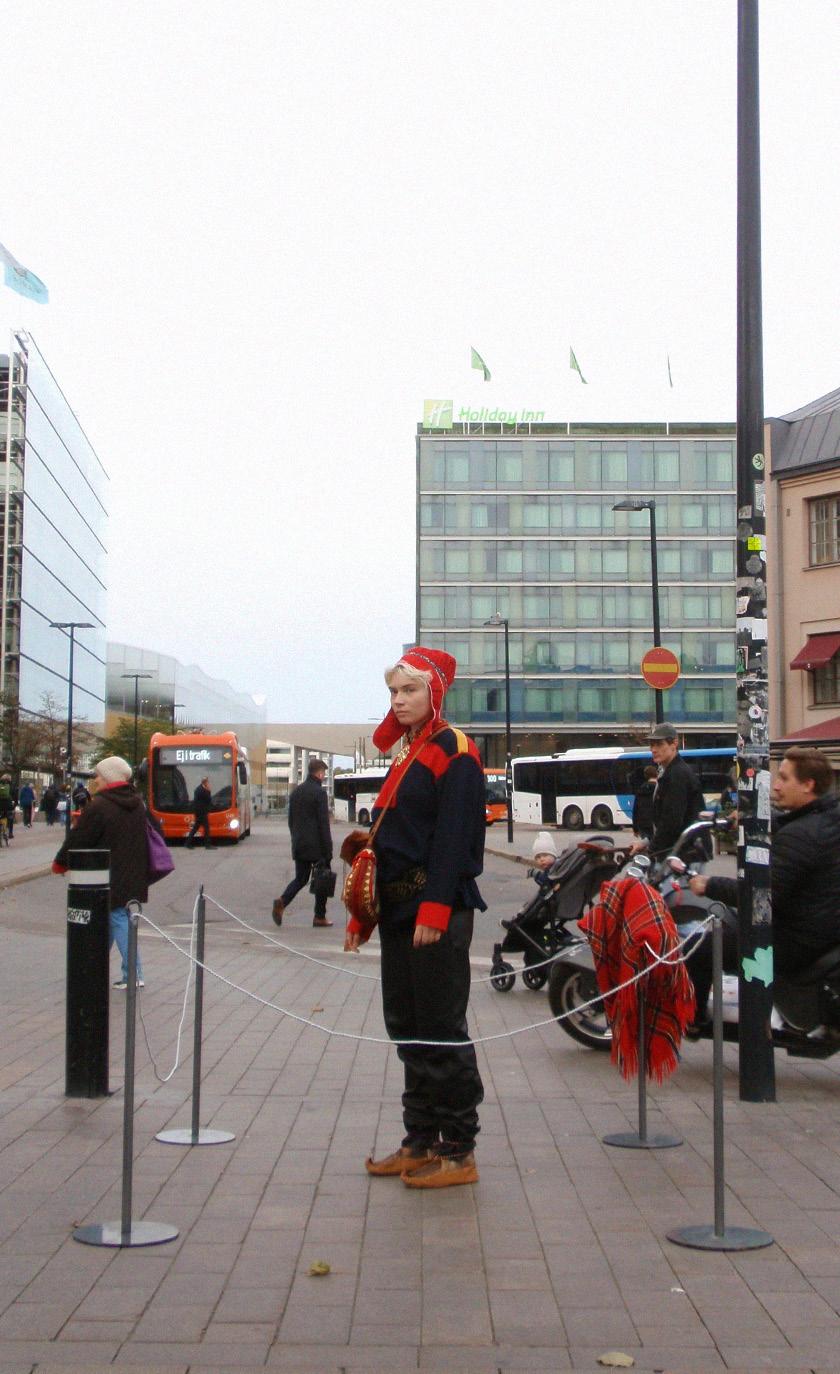 Lotta Hagelin, Helmi, Spotted, series ‘Museum Property’, 2023, digital photograph.
Lotta Hagelin, Helmi, Spotted, series ‘Museum Property’, 2023, digital photograph.

Lotta Hagelin, Museum, Discovered, series ‘Museum Property’, 2023, digital photograph.
46

One plus one becomes three
Impropias Collective
47

Impropias Collective researches Latin American identities from an embodied, situated, and feminist standpoint. In Spanish, “impropia” is the female form for inappropriate, for something inadequate or untimely. It is also a play of words between “improvisation” and “propio”, which means cool and street-smart in Ecuadorian slang. Te collective was founded by Mercedes Balarezo Fernández, Yes Escobar, Paola Nieto Paredes, and Daniela Pascual Esparza in 2021. cuerpalatina is their frst collaboration.

Mercedes, Yes, Paola, Daniela, and I met at Humina Association in Länsi-Pasila, Helsinki, on March 14, 2023. I joined Impropias for their rehearsals. Te three tasks that follow this conversation were produced afer our meeting, answering this prompt:
How does your experience of space and movement during the performance cuerpalatina relate to threshold elements?
By threshold, I imagine an element (physical, visual, expressive, organic, conceptual, etc.) that separates and connects spaces and is defned by movement. A threshold can be:
◊ an aperture by moving across it,
◊ a contact zone by moving towards it or gathering around it,
◊ a space to inhabit by lingering on it, or
◊ a device to control interaction.
48
Mercedes, Yes, Paola, Daniela, and Micol
Paola: How does one invite people to dance?
Mercedes: “Would you attune with me?”
Impropias Collective, cuerpalatina, Y-festivaali by the Ministry of Justice, October 2022, Helsinki. Images courtesy of Y-festivaali.
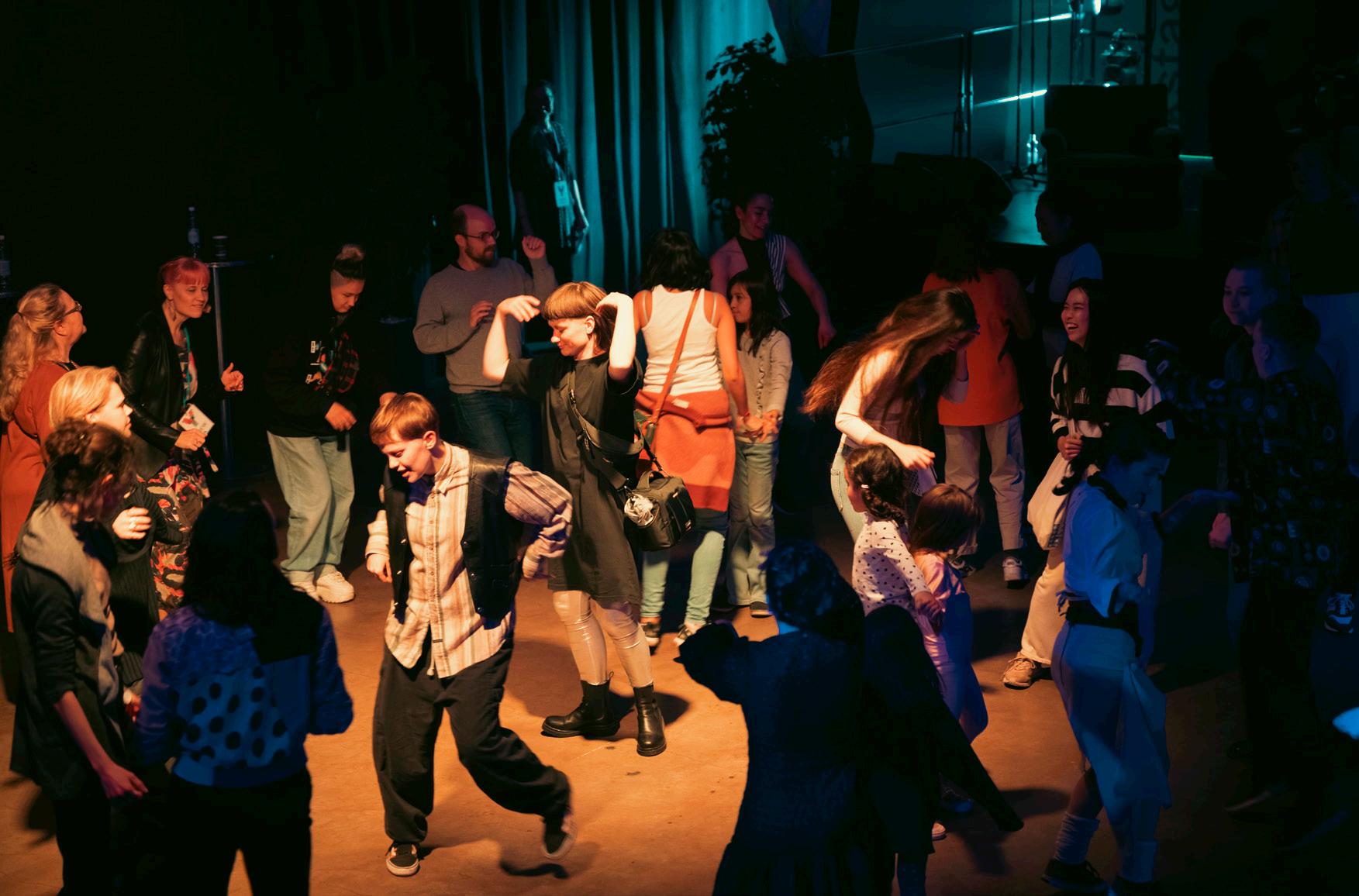
49
Micol: While we were dancing together, you all were at the perimeter of my sight. Te room got smaller because we were defning the space. Maybe the centre wasn’t one of us but somewhere between us.
Rehearsing seemed almost like a quest for an internal movement, which slowly gets analysed through the body. As it gets out, it starts to fnd a connection, and then there seems to be a conscious decision to open this movement to others.
Yes: More than movement, I think we’re trying to paint certain landscapes.
Micol: Achille Mbembe writes about the idea of ‘re-membering,’1 which resonates with what you, Mercedes, were saying about deconstructing movement: centres, patterns and energies; the connection between memory and the analysis of its motion.
Mercedes: Yes, there’s a lot of bodily memory that comes from the music, or the music comes from bodily memory.
Paola: In one part of my scores, I used music that brought me back to the image of being in Mexico City, in the market, on the bus, to how my body feels in that space, adapting those feelings to the
50
context and the site of the performance.
Mercedes: Because the music visits us again, this re-membering is like re-building memory in your limbs. Tings overlap; the old memory and the reconfguration of the dance, the people we are here now in this country, and the people we were in our childhood.
Micol: Tere’s a relation to identity and urban spaces, at least in your [Paola’s] memory: the idea that we move diferently in diferent cities.
Impropias Collective, cuerpalatina, FOE Fest, July 2021, Helsinki. Co-funded by Taiteen Edistämiskeskus/ The Arts Promotion Centre Finland. Photos by Vitali Gusatinsky.

51
Mercedes: It has been at the forefront from the beginning: what is it to be a “Latin person”? Where does this “Latinity” lie? What are the things that we want to associate with it?
Daniela: Our cultural heritage is what we can bring forth, explore and experiment with; it’s been our common ground. Te experience of “being away” is something that we deal with every day. It has been the starting point and the channel. But I think that, eventually, the project is a lot about dancing together, about what it takes to get people to dance, and how to promote dance and conviviality. Of course, having had that experience growing up, that dance was not something extraordinary but everyday, this cultural heritage has shaped our corporeality and how we experience the world.
A big part is about identity, yes, but cuerpalatina goes beyond that and is perhaps about something else ... or something more than that. Like, when one plus one becomes three.
I always go back to myself dancing in the kitchen. I think about what Mercedes says, “You cannot share what you don’t have.” How to embrace identity without being trapped in it.
Afer the performance at Svenska Teatern, I went to an actual party where people were sweating
52
and dancing, and you couldn’t see where the centre was, and you were all part of the same body. I would like the performance to feel like that, like: “What the hell is going on!”

Paola: We want a big party!
Mercedes: Yeah, we have a very clear goal: we want people to party. Maybe it’s a memory of our own experiences; when there is a great party, everybody loses themselves in the movement, “I
53
Impropias Collective, cuerpalatina, the New Theatre Helsinki Festival at the Svenska Theatre, February 2023, Helsinki. Photos by New Theatre Helsinki and Quentin Wachter.
don’t know if you’re my friend or not, but we are together! Eah, eah!”
When bodies dance together, the hierarchies change too. Of course, social constraints are still present, but something is stated when we’re in relation to someone else dancing. It’s what we’ve just experienced: this attunement. Suddenly, I experience the person next to me move so freely, and I start to move a little freer too. It isn’t even a conscious decision, but the body starts to speak its own language.
Micol: I felt that at the theatre, you were playing with infrastructures. I have started reading Gloria Anzaldúa’s writings, her concept of la mestiza being a mediator, reclaiming a zone that allows them to tap into diferent worlds.2 Te way you used the space of the theatre was allowing you to walk on this border line between structures: between the stage and the audience, or between the upper and lower side. Redrawing spaces. Maybe it relates to what Daniela was saying, that it isn’t only about identity but more about interaction and drawing contact. How can this expand to spaces, too?
54

55
Impropias Collective, cuerpalatina, FOE Fest, July 2021, Helsinki. Co-funded by Taiteen Edistämiskeskus/ The Arts Promotion Centre Finland. Photos by Vitali Gusatinsky.
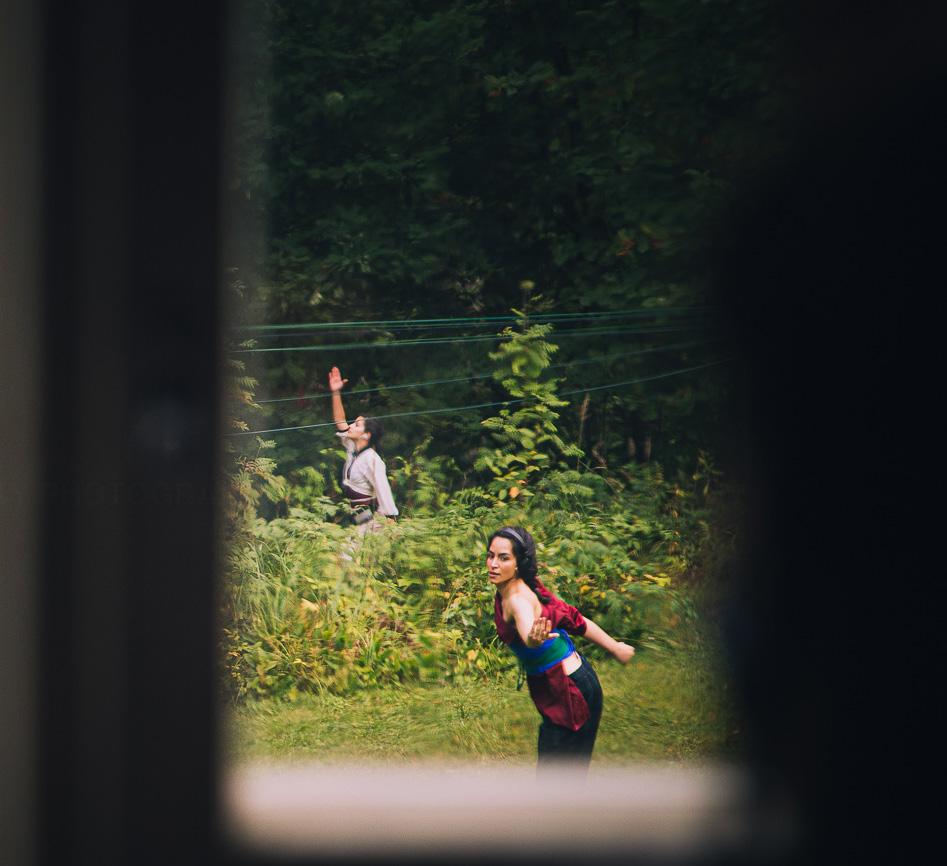
56
Paola: Te space is a character in itself.
Yes: We like to occupy the location. We are also deconstructing how spaces are being used. We take over in a way that goes from uncomfortable to less uncomfortable to hopefully togetherness. We will never be on stage unless it’s with the audience.
Daniela: And when I don’t know what to do with the space, I play with it as if there was another body. When I have to perform, I might as well let certain parts of my bodily way of being go from the private to the public. Tat ofen becomes a threshold in the performance for me.
57
Yes Escobar,
A somatic exercise for the exploration of quality over shape

You need at least two people for the exploration. Before the exercise, gather one or many some-things that embody the following
qualities:
◊ Hard ◊ Sof ◊ Liquid ◊ A smell you like ◊ Cold ◊ Tasty
58

Somatic exploration
Read the following instructions in any given order. Change the reader afer each round.
Gather all your somethings around you. Close your eyes. When coming into contact with your somethings, try to focus on the sense of touch as your only means of understanding. Sometimes, you will be invited to share this experience in the form of movement. Try to relate the movement to the knowledge acquired/activated/ remembered by the experience. Now, close your eyes.
Exploration instructions
If you can, pick up something hard. Press your fngers around it. What is the texture like? If you can, press your chest against it. Feel it there for a little while.
Make contact with the liquid. Can you touch it with your fngers? What temperature is it? Does it have a smell? Can it move? In which ways? Is it good to drink? How do you know?
Move to express knowledge
Find something to eat. Give it a nice bite. How does it feel?

Touch something sof and something hard at the same time. Why did you think these somethings represent antonyms?
Move to express knowledge
Keep something sof in contact with you from now on and until the end of the exploration.
Find something that smells nice. How can you best sense the smell? Is it better to be close or far away from its source? How can you know where the smell comes from?
Move to express knowledge
Put one foot on something cold. Now, the other foot. Now, one palm, try closing the palm. Now, repeat on the other hand. Keep it there until you cannot handle the cold sensation.
Move to express knowledge
Take something sof away from you.
Find something to eat. What does it feel like? How can you know this is food? Take the food close to your nose and open your mouth just a little bit. Press your nose against it if you can.
Take something sof away from you.
60
Daniela Pascual Esparza,
El Ave del Paraíso Blanca

El Ave del Paraíso Blanca es una planta oriunda de África del Sur. Sus hojas se parecen a las del banano y es fácil confundirlas: ambas son lisas, grandes, y fuertes. Y sin embargo, el aire las acaricia hasta partirlas. Yo las miro moverse en las alturas, me siento alegre, ligera, y pienso en estos versos de Rubén Bonifaz Nuño:
te lo abrán dicho ya, que nadie muere de ausencia, que se olvida, que un lamento se repara con otro, y es el viento o la raya en el agua que se hiere.
Y así, una hoja se convierte en pluma, de una fsura nace un movimiento, y mi cuerpo descubre nuevas formas y texturas; el sonido de la lluvia.
The White Bird of Paradise is a plant native to South Africa. Its leaves remind those of banana trees, and it’s easy to mistake them: both are big, smooth, and strong. And yet, the wind caresses them until it breaks them. I look at them move high above, feeling light, feeling joy, and recall the words of Mexican poet Rubén Bonifaz Nuño:
te lo abrán dicho ya, que nadie muere de ausencia, que se olvida, que un lamento se repara con otro, y es el viento o la raya en el agua que se hiere.
And just like that, a leaf becomes a bird, a crack invents a movement, and my body discovers new textures, new shapes; the sound of rain.

Cuando camino y todo está quieto, y lo único que escucho es el caucho de mis botas pisando la nieve, me inunda un recuerdo falso, inventado, de una fnca en Babahoyo, platanares por doquier, y el sol abriéndome la piel. El aire denso y húmedo derrite mis toxinas, mi cuerpo se expande, y así, mientras el frío arruga mi piel y me siento ajena al milagro de este paisaje, repito: que el desapego no me impida apreciar la belleza que aquí habita, que el desapego no me impida apreciar la belleza que aquí habita. Camino, me despliego, y por un momento me siento cerca de mi abuelo, de la guanábana que crece en el patio, de mi abuela convertida en pájaro, de aquel río que yo también crucé en balsa. ¿Qué miras tú cuando me ves bailar? Yo a veces lloro sin llorar, y otras dejo que me atreviese un rayo de luna, que me habiten todas las vidas no vividas, un Mapalé colombiano, el polvo de la calle, un dembow, el cóndor de los Andes, un balcón en primavera y Quilapayún. Cada poro de mi piel es un umbral y todos los días una tarde de domingo: un instante en el que tú y yo nos podemos encontrar, bailar quizás.
When I walk and everything stands still, and the only sound I hear is the rubber of my boots against the snow, I’m invaded by a false memory, an invented memory of a fnca in Babahoyo, banana trees everywhere, the sun piercing my skin. The air there is thick and humid. I feel myself melting. I expand and so, as the cold wrinkles my skin and I feel foreign to the forest and the miracles around me, I repeat: may indiference not prevent me from acknowledging the beauty of this place, may indiference not prevent me from acknowledging the beauty of this place. I keep walking, I unfold and, for a moment, I’m near my grandfather and the soursop tree in his garden, near my grandmother who’s now a bird, and by that river, I, too, have crossed. What do you see when you watch me dance? Sometimes I cry without tears, and other times I welcome the moonlight, lives I’ve never lived, a Colombian Mapalé, the dust from the street, a dembow song, the Andean Condor, a balcony in Spring, Quilapayún. Every pore in my skin is a threshold and every day a Sunday afternoon: the chance for you and I to meet, perhaps to dance.

63

64
Mercedes Balarezo Fernández, Mapa del cuerpo, 2023, sketch.
1. Achille Mbembe, ‘Bodies as borders’, From the European South 4 (2019).
2. Gloria E. Anzaldúa, Borderlands: the new mestiza = La frontera (San Francisco: Spinsters/Aunt Lute, 1987).
65
66
Trying not to build walls

Eliisa Suvanto, Porin kulttuurisäätö
67

Eliisa Suvanto is a curator-producer and one of the founding members of Porin kulttuurisäätö, an awardwinning collective combining artistic research, production, and curatorial work. In addition to annual exhibitions and events, the collective produces public talks, consultancy, studio visits, and political advocacy work. Previously, Eliisa has worked as the director of the artist-led space Titanik in Turku and as programme manager of PUBLICS in Helsinki.

Tis conversation was compiled in diferent moments, through written and spoken dialogue, in December 2023. Eliisa and I worked together in other instances, while I was introduced to Porin kulttuurisäätö’s work through their exhibitions Evergreen Inner Jungle (2021) at Kaisaniemi Botanic Garden, Helsinki, and #Holiday365 (2023) in Sotkamo, Kainuu.
68
Eliisa (E) Micol (M)
E: Porin kulttuurisäätö and Space Invaders were born under diferent circumstances but back to back, driven by the need to actualise something concrete, to put the theory into practice, so to say. We wanted to bring visibility to a programme (the MA in Visual Cultures, Aalto University, at the time based in Pori), which addressed questions – for example, thinking about the public space – that weren’t as common in the cultural practices of the time. Since 2013, the projects have grown into platforms where our collective practice manifests strongly.1
Porin kulttuurisäätö, an “imaginary foundation” (in Finnish ‘säätiö’, but in this case missing one letter, which then translates into ‘hustle’), and what was built around it, we considered to be “the work of art”. Tat is, what we were able to collectively produce by using the so-called foundation as a platform.
1 The frst ever Porin kulttuurisäätö project, The Sponsor, was realised with a one time working group (Anna Jensen, Niilo Rinne, Eliisa Suvanto, Eetu Henttonen and Anni Venäläinen) all connected to Aalto’s MA program. Since then Jensen, Suvanto and Venäläinen continued Porin kulttuurisäätö as a collective working on site-specifc practices. In 2024, Porin kultuurisäätö consists of Jensen, Suvanto and Sanna Ritvanen, who joined the group in 2020.
69
[We laugh.]
M: Okay, this connotation of “the work of art” is interesting, maybe a bit counterintuitive to its conventional meaning. Isn’t it something that you’ll need to explain?
E: Do I?
I'm going to stop you right there. You can think of it as a gesture implying that there are multiple people, multiple voices in our projects, and collective moments of discussion and mutual impact along the way. It suggests that roles can be muddy and that all the elements in this picture – the location, the bureaucratic structures, the artists, the possible hosts, ourselves, etc. – are equal actors.
We work with site-specifc research questions, mainly commissioning artworks that respond or react to these terms, and collectively with artists and other professionals who create resonance on an individual level and the project at large. Te exhibition always shifs in unexpected directions. [Eliisa smiles.]
70
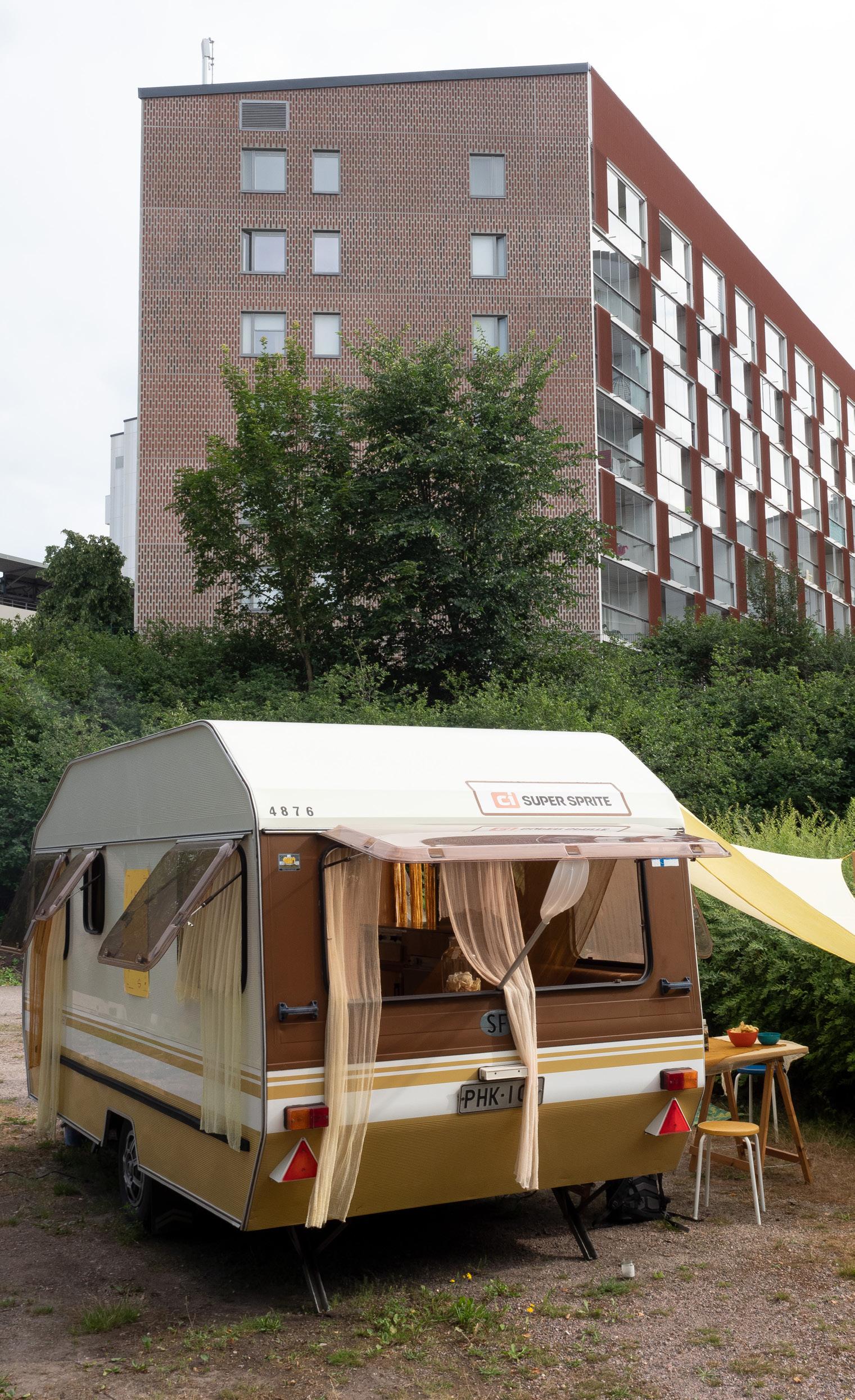
Michaela Casková, Small Talk #9 Walking through, taking in, soaking up and again. Porin kulttuurisäätö, Pori Biennale Visitors , 2022. Rastila, Helsinki, Finland.
Photo credits: Erno-Erik Raitanen.
E: One recent example is Pori Biennale Visitors (2022) in Eastern Helsinki, where the original location was the vast natural area of Kallahdenniemi. Artist Michaela Cascová wanted to include the Rastila camping site, expanding the exhibition both physically and thematically. In the end, an artwork by Venla Helenius was shown at the camping site, too. Te exhibition continued in the suburb of Meri-Rastila, where Kaija Hinkula’s work was installed, moving through the local nature with forests, beaches, peaks, and meadows. Te concept of “work of art” involves the agency of the exhibition’s sites too, which can be multiple within one project. Te site is never a backdrop but a crucial element, communicating with the artworks and to the visitors, and vice versa.
M: Porin kulttuurisäätö and Space Invaders seem to hold an insistence on work, “the hustle”, of squatting a format or a structure. Whether it is hijacking the format of a foundation or literally squatting an empty place, to me, this seems to pursue a certain way of working more than establishing a stable entity.
E: Yes, they indicate the taking over a physical space or an idea. Ofen, in the process of fnding potential in a new site, we work with one further collaborator – beyond the artists and our working group – which brings its own agenda
72
and activities, being potentially other than art making: for example, Kaisaniemi Botanic Garden in Evergreen Inner Jungle (2021). All our projects try to facilitate the knowledge or activities already existing at the site, while adding another layer. Also, we’ve never returned to the same site twice.
M: Isn’t that a form of resistance? It sounds exhausting ...
[Eliisa laughs.]
E: It is. It is.
M: My question was also pointing at funding systems. Maybe directing the focus on how you work, rather than having a fxed homebase, allows you to work around these norms too?
E: Yes, but there are pros and cons. How interesting and difcult it is to “sell”, so to say, a way of working as your practice. How to put a “label” to this fuid collaborative work across multiple sites while purposefully and explicitly trying not to build walls? It becomes a question of sustainability, because operational funding in Finland, also on the regional level, ofen supports walls [organisations with a fxed base]. In a way, we are consciously going against the grain and some parameters of these funding systems.
M: How do you mould your exhibitions into the
73
horizon known by the locals? In the introduction to last year’s Visitors, you defne the guests and the locals as ‘producers of the exhibition.’2 How do you deal with and build site-specifcity?
E: It’s important to recognise that our projects aren’t participatory, in the sense that we don’t work directly with local communities on a large scale. Tere are many reasons for that, mostly it comes down to resources and that we move location each time. It’s always a restart. So we recognise we won’t be able to fully navigate local knowledge(s) – which are already always multiple. Nonetheless, there are clear reasons drawing us to a specifc location. Te ‘intimate outsider’ position is a helpful way to articulate our role.3 We are always present in the exhibitions while they are open to the public, so the exchange and articulation of our work happen then, too.
Recognising others as co-producers must be the case when working in public spaces. It’s one way of admitting that we don’t have full control of the process or the outcome – which is horrible and wonderful! Tis is why we work as we do: these processes always have something to ofer that we alone couldn’t have imagined, and that’s what moves us forward. We are keen to be present and engage with the visitors because they feed our thinking, and we can only hope it goes both ways.
74

75
FEMMA Planning, Lähiölaboratorio, 7 July 2022. Porin kulttuurisäätö, Pori Biennale Visitors, 2022. Vuosaari, Helsinki, Finland. Photo credits: Erno-Erik Raitanen.
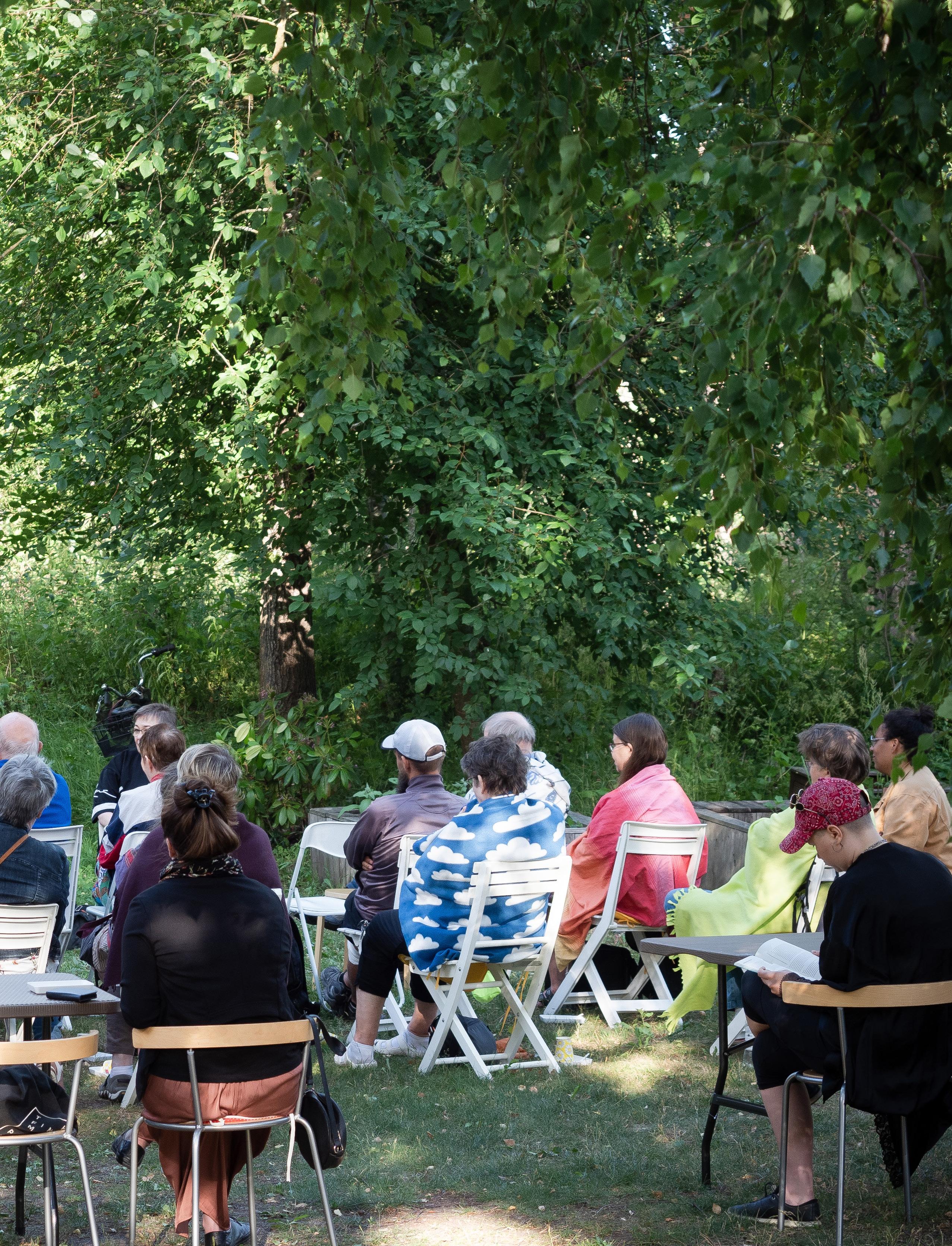
76
M: Being present on-site and the self-awareness you bring into the project reinforce your accountability and self-positioning. Tis efort to gather people and talk isn’t necessarily about the location and its inhabitants, but has been thought for and with them. Can you recollect some of the conversations you’ve had with your visitors?
E: Tey could literally go any direction! When we started, the exhibition took place while the Pori Jazz Festival and Suomi Areena (the biggest public platform for debate in Finland) were happening in Pori at the same time. Tey brought tens of thousands of people to a city of modest scale. Pop-up exhibitions and art events started to cater for these guests. As local practitioners, we wanted to provide another perspective on what Pori could ofer. We directly addressed how people engaged with the exhibition in an urban setting.
Pori World Expo (2015) is still one of my favourite exhibitions: a white pavilion with a pool surrounding the building and a pathway to cross the water to get to the installation. Tere was no material artwork inside. Te artist’s name, a short description of the work, and a phone number were in place of the artworks, which were expressed in performative and conversational formats through a phone call. It was confusing for some visitors, and we were
77
present to fgure things out with them. Tis confrontational aspect was a great school for us to talk transparently about who we are, where we come from, what we do, why exhibitions can also take these forms, and what’s the point of it.

Porin kulttuurisäätö, Porin Maailmannäyttely (Pori World Expo), 2015. Pori, Finland. Photo credits:
78
Niilo Rinne.
M: You work in spaces that people feel familiarity and habit towards. Maybe this is like being in someone’s home and telling them that the view from their window is diferent when you look at it upside down: challenging one’s perspective the way a friend would. You write that ‘art has the power to alert if we choose to pay attention,’ and about ‘giving enough keys’ as a way of making this challenge accessible.4 Can we talk about accessible language?
E: We’ve had the tradition of producing a catalogue, even with modest resources. Our goal is to translate our processes and thinking in the best possible way. Tis means articulating the starting point, how we got there, and sharing some of the pros and cons on the way. So the work can become relatable. Working in spaces that people feel care towards, our relation with the audiences starts, at least, from a shared appreciation for the place. A collective imagination also helps when talking about accessibility.
M: What do you mean by “collective imagination”? Is it a shared understanding?
E: I don’t think it can be “shared”, in the sense that everyone would need the same experience, background, or point of view. But “collective” exactly because it includes all of these
79
perspectives, even in a scattered manner. To me, collective imagination is about these layers and leaving room for personal navigation. It reminds me of the project Te Truth About Finland (2017), which we produced for the centenary of Finland’s independence. Even the title is a paradox, as there is, of course, no one truth, and our approach was to bring 100+ contributors to talk about what independence means.
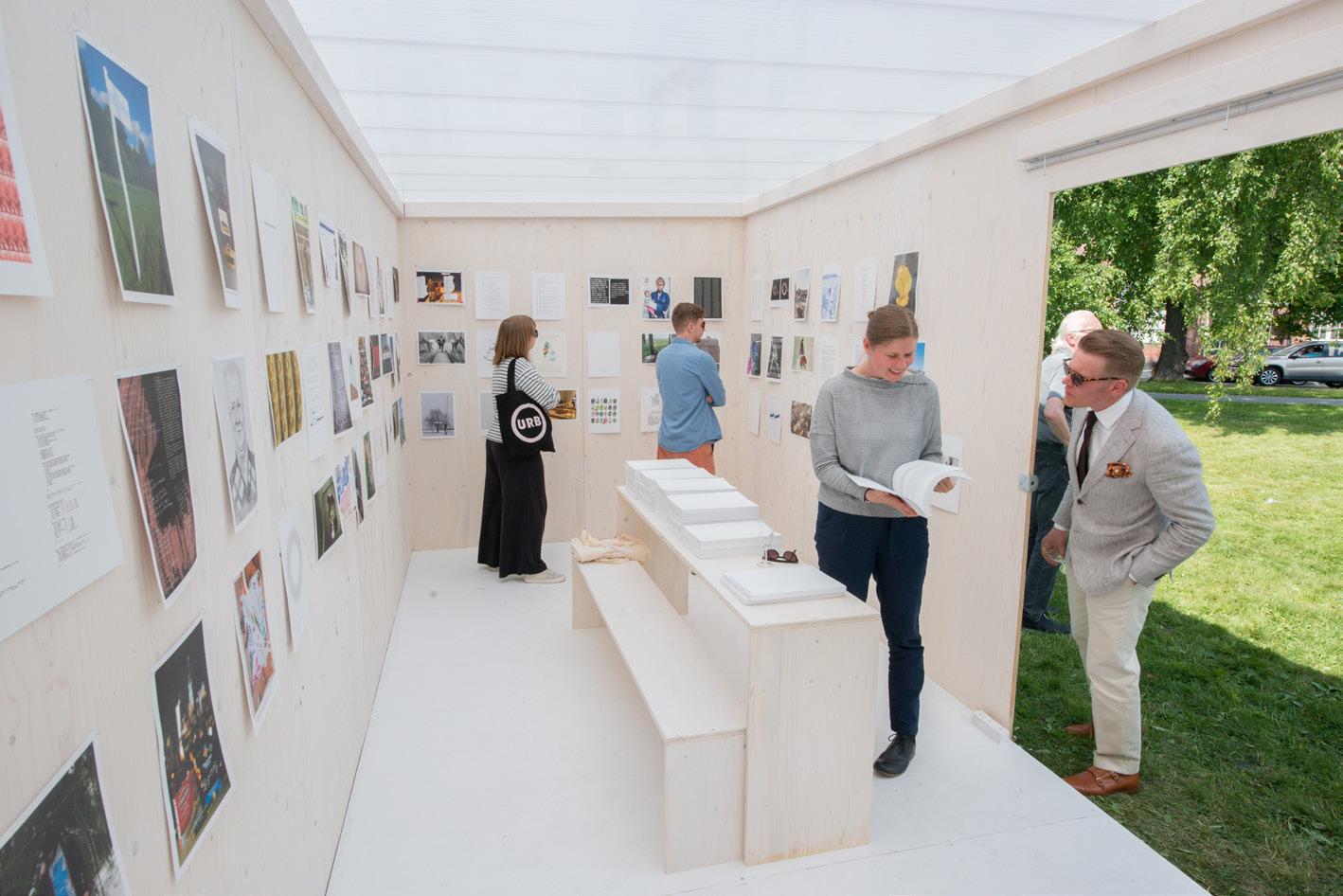
80
Porin kulttuurisäätö, Pori Biennale Totuus Suomesta (The Truth About Finland), 2017. Pori, Finland. Photo credits: Niilo Rinne.
M: So, collective is what is produced by a number of diferent voices …
E: And is open …
M: And purposefully comes together …
E: And there is a framework to which each one adds on.
M: Ten, collective is something that is wanted and built?
E: Yes!
M: Great! [We laugh.]
M: Somewhere you’ve described the curator as ‘a cushion’. I like that image.
E: Have we said that? I like that image too, and it reminds me of the exhibition by curatorial duo nynnyt, Between a rock and a hard place there is sofness (Titanik, 2018). It’s important that everyone in the team is aware of what is happening with the others rather than having completely isolated processes. We encourage our collaborators to use the project to experiment or try new things. And it’s been lovely to work with a few artists long-term. In her recent dissertation, Anna Jensen calls these artists
81
‘double agents’ because they and their knowledge are situated somewhere between us and new collaborators.5
M: I’d say that the aesthetic of your curating plays with some sort of “magical modesty”. I read it as a way of producing and encouraging cohabitation – of art and the built environment, with its contradictions, everyday tensions and possibly difcult conditions – instead of competition between the two. Tis counteracts the traditional language of public art, which tends to be grand and authoritative, making the viewer passive.
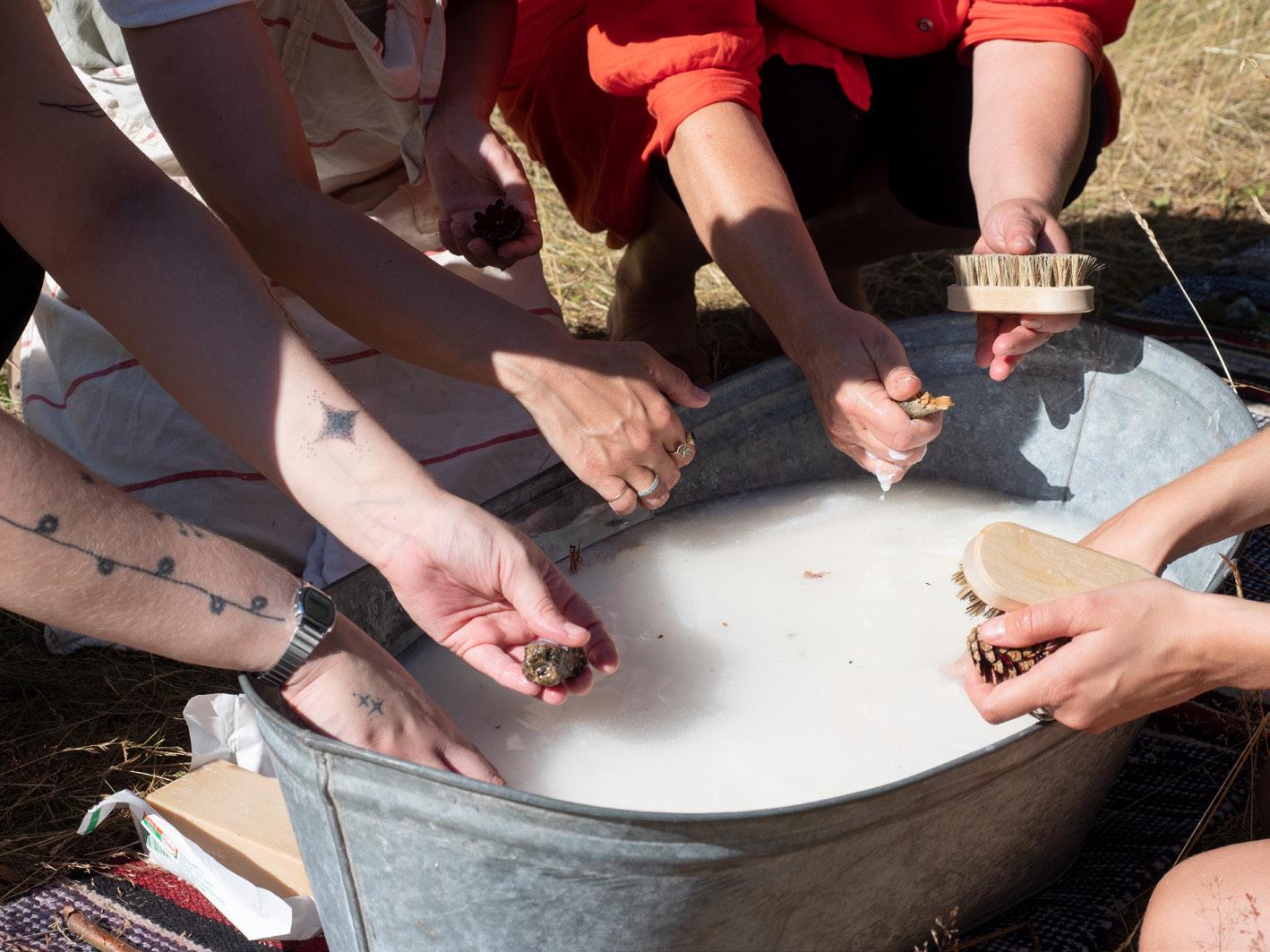
82
Taidekoulu Maa, Art School MAA Day, 20 July 2022. Porin kulttuurisäätö, Pori Biennale Visitors, 2022. Rastila, Helsinki, Finland. Photo credits: Erno-Erik Raitanen.
E: Yes, I really like this way of putting it. It reminds me of vähätaide (I’m not sure how to translate it accurately, perhaps “minor art”), a term that artist, curator, and writer Kari YliAnnala has used to describe our practice too, referring to Deleuze and Guattari for its origin.6 In vähätaide, rules and customs are twisted or redefned, everything is political and linked to communal values. In the public space, the surroundings and the artworks don’t need to compete but should rather communicate with one another. Ofen, this tension is dismissed with “Te artwork doesn’t add anything to its environment,” and then I wonder if the whole deal is of, if the problem comes from how art was articulated to begin with, as the visitor expects a museum-like experience where the artworks are in a fully controlled situation with no interruptions. Modesty comes down to resources, too. Working with pre-existing locations, we have built our practice around using what we have, what we can access and, again, what is worth being alert of – is that how you say it?
M: I guess? I like it! Being alert is an interesting way of looking at things. It suggests militant aesthetics, a way of moving into the world caring enough to look hard, notice, and express. Art and exhibitions can facilitate this. I appreciate that it expects responsibility and efort from all sides – producers, artists, and audiences alike.
83
Everything comes down to behaviour, attitude, and attention. In your experience, how is public space perceived in Finland?
E: I don’t know if there is such a thing as a cohesive idea of public spaces, as I don’t think there can ever be consensus. Chantal Moufe, for example, suggests that public space is always in confict due to its inevitable pluralism.7 In general terms, public spaces in Finland are approached with obedience and respect. Tere is a code of conduct on how to behave to avoid causing distress to others. Public life here sufers from the long winters: gatherings take place indoors, they become exclusive; private or semi-public sites, such as malls, become “public spaces” despite mainly serving a consumerist agenda. In my mind, Finland is extremely rooted in the Nordic welfare state, where civic action, protests, and activism are generally not so valued; the mentality is that decision-makers know best, and individuals simply want to mind their own business. Tis is hopefully and already changing. In terms of working with projects in the public space, the amount of rules, regulations, and people who are simply gatekeeping is endless. At the same time, cities’ rebranding strategies ofen come down to a few harmless events that carry no critical questions or aims.
84

85

Anni-Anett Liik, UNNAMED FOREIGN BODY. Porin kulttuurisäätö, Pori Biennale Visitors , 2022. Kallahdenniemi, Helsinki, Finland. Photo credits: Erno-Erik Raitanen.
86
E: In 2018, we published a questionnaire asking people what their expectations and desires towards contemporary art were, and the majority felt warmly towards “being surprised” in their everyday context. To me, this links to the act of alerting. As Lucy Lippard suggests, all of our surroundings are one big ‘lost and found,’ and the real work starts afer the fnding.8
M: Finding what?
E: Te place! Lippard talks about engaging with the surroundings and how, beyond one’s curiosity or attention to the site, to work with that location, to “pick it up” from the lost and found, you’ll have to go through such bureaucratic mayhem. Tis is our experience too, dealing with the infrastructures of various cities. As you enter their chain of command, most of your time, resources, and patience will need to go into navigating diferent interests in the public space, ofen with opposing logic and little reliability. One big part of the job is fguring out how to work, in any capacity, with spaces that should be of public access. We try to articulate the politics of the locality in each project.
87
1. Te frst ever Porin kulttuurisäätö project, Te Sponsor, was realised with a one time working group (Anna Jensen, Niilo Rinne, Eliisa Suvanto, Eetu Henttonen and Anni Venäläinen) all connected to Aalto’s MA program. Since then Jensen, Suvanto and Venäläinen continued Porin kulttuurisäätö as a collective working on site-specifc practices. In 2024, Porin kultuurisäätö consists of Jensen, Suvanto and Sanna Ritvanen, who joined the group in 2020.
2. Porin kulttuurisäätö, Pori Biennale 2022 - Visitors, 2022 (https:// porinkulttuurisaato.org/projects/pori-biennale-2022-visitors/).
3. Porin kulttuurisäätö, Pori Biennale 2023 - #Holiday365, 2023 (https://porinkulttuurisaato.org/projects/holiday365-catalogue/).
4. Porin kulttuurisäätö, ‘In Praise of Pällistely: Art, nature and tourism as felt and imagined experiences’, ed. Neal Cahoon, Miina Kaartinen, mirko nikolic and Anu Pasanen, Mustarinda: Elinvoima (2023).
5. Anna Jensen, ENCYCLOPEDIA OF IN-BETWEENNESS. An Exploration of a Collective Artistic Research Practice (Espoo: Aalto ARTS Books, 2023), 177.
6. Kari Yli-Annala, ‘Saaristo ja rihmasto: vähätaiteesta, vähäisistä taiteista ja vähän vähemmistötaiteestakin’, Mustekala, 6 March 2023 (https://mustekala.info/saaristo-ja-rihmasto-vahataiteestavahaisista-taiteista-ja-vahan-vahemmistotaiteestakin/).
7. Chantal Moufe, Te Democratic Paradox (London: Verso Books, 2000).
8. Lucy R. Lippard, Undermining: A Wild Ride Trough Land Use, Politics, and Art in the Changing West. (New York: Te New Press, 2014), 304-305.
88
From us to us

Alice Mutoni, Ubuntu Film Club
89

“Expanding narratives, with a twist of fun, one flm at a time” is the motto of Ubuntu Film Club (UFC). UFC organises flm screenings in Helsinki since 2019, giving visibility to minorities’ stories and storytellers. Te screenings are free of charge and open to all. Tey deal with urgent topics such as the war in Congo, sexual violence against women, and the lives of LGBTQIA+ people. Te flms are followed by discussions with experts, occupational therapists, activists, and flm directors, who open up these issues with the audiences. Most visitors are between 16 and 35 years old. UFC founders are Alice Mutoni, Rewina Teklai, and Fiona Musanga.

I frst attended Ubuntu Film Club’s outdoor screening with PopUp Kino in Aurinkolahti in August 2023. I was then in touch with Alice, and attended their event produced in collaboration with Tink Afrika. Tis conversation was recorded on January 18, 2024.
90
Alice (A)
Micol (M)
A: I was watching a lot of documentaries; it was easier for me to digest information that way rather than sitting through a book or a lecture. I was learning, and I thought we could start a flm club to show documentaries and open up the topics in a discussion.
Tis was 2019. A lot was going on in the media about immigration; those conversations were happening either virtually on social media or in academic spaces. Bringing them to a less intimidating place, like Museum of Impossible Forms (MIF), was inviting people to come, learn, or just observe without needing a specifc background or prior knowledge.
91

M: MIF ofered their space when you started and, since then, you have attracted the interest of many other organisations around the city. Do you think there’s a lack of capacity in the local cultural feld to produce projects like Ubuntu, which created a lively world from the simple format of a flm club? In your experience, what are the cultural or material barriers preventing similar projects from happening?
92
Ubuntu’s christmas screening at MIF, 2019
A: When we started Ubuntu Film Club, there was nothing like it in Helsinki: three young Black women organising documentary screenings. Many were curious and really wanted to support us; they seemed eager to help younger people get on their feet. Honestly, we knew nothing about licensing, screening fees, grants ... I assumed I would have paid out of my pockets. MIF was able to help us with that. Te difculty isn’t in keeping the ball rolling or imagining what the project could be but in knowing how to start if you aren’t already inside the scene.
M: Is it accessible information that is lacking, to begin with?
A: Tat’s it.
M: You were 21 years old when initiating Ubuntu Film Club, and the majority of your audience consists of young adults. Can their participation tell us something about a generational experience when it comes to access to communal spaces in Helsinki?
93

A: People come to our events because they feel comfortable, because it is from us to us. When people arrived a little early, and we were still organising the space or making sandwiches, everybody would jump into the kitchen. Tere was no diference between us running the club and them; there were no rules. Te space was stripped down of those power dynamics.
When I think back to it, that on a Sunday evening and in the winter, people would sit on those little foldable chairs to watch our documentaries, plus
94
Homecoming and Beyoncé’s party at MIF, 2019
the discussion aferwards ... Man! Tat space was really important! It was needed for many.
M: I was looking into people's reactions to your events when I came across an article that described the atmosphere as “expectant […] It is hard to believe that you are in Finland.”1 I’m always intrigued by statements like this, which play with expectations connected to geography and nationhood. If you feel comfortable, I’d like to talk about belonging. You shared with me about wanting to move abroad and how organising Ubuntu helped you make a home in Helsinki. What was lacking in your experience of living here that Ubuntu has fulflled, and how?
A: In 2018, I was travelling to London, where there was such a boom of cultural happenings: a lot was organised by young artists, club events focused on African music, open mics ... It was my frst time there, and when I came back, I was bored. Where are all the people? Black Femme Film inspired me to start Ubuntu. It was fascinating because, in Finland, people were still getting used to using terms like ‘POC’, while in London, there were successful events on Black women and femmes in flm. I needed to create something to resemble that. I didn’t even think about limiting the target audience because there was no other active flm club and because to have the discussions we wanted to have – about
[Alice laughs.]
95
racism, for example – it’d have been important to have non-Black people come into that space, learn, and ask questions. I called it Ubuntu, and we started. It became my baby. I wanted to invest in it, and the people who came to the events became really, really important to me. So, I no longer felt like I had to run away from Helsinki to feel what I had felt in London or what I thought people felt in London. Now I have that here.
M: Te flms you screen ofen address complex topics. Can you talk about the response of the audience and how you are hosting the space for these conversations? Is there any particular comment or a moment that stays in your memory from these discussions?
A: Te frst ever flm we screened was City of Joy: Turning pain into power (2016). It is about a women’s centre in the Congo where women who have been sexually assaulted and who have experienced violence in the midst of war, would go to tell their truths and learn ways to heal from those traumas or to cope with them. It was heavy. I’m no expert in the history of the war in the Congo, so we called in someone who could talk to us about it. My main point was to learn from the events myself. Te reaction to that flm was what kept us going! Many young people, also of African descent, didn’t know about what was happening in DCR. We had an open space to interact in a
96
language accessible to us. Language is really, really important. Seeing young people excited to learn, open to asking questions, and receiving the answers was lovely. It was really lovely.
I’ll never forget our screening in Ateneum. Te flm was Rafki (2018), about a lesbian couple in Kenya, and it was in Swahili. A friend of mine who is from Kenya and part of the LGBTQ+ community said, “Never in a million years would I have thought to be in Finland watching a flm about queer people in Swahili without having to read the subtitles!” On top of that, it was in Ateneum, not a familiar space to our audience. Tis was during our frst year, in collaboration with UrbanApa. It felt big! When Sonya Lindfors said we could make it happen, I got nervous because ... you know, at MIF, we would scream and run around, have a drink and a laugh, it was so light! I was scared that going to Ateneum would change the atmosphere: would people feel that they must manage their reactions, the way they act, the way they talk? Sonya said, “No, we are going there and we are going to be ourselves, do our thing.” So we were in Ateneum playing Afrobeats. It was liberating.
[Alice smiles.]
97

M: You, Rewina, and Fiona have been referred to as ‘young power women.’2 Do you identify with this power? What do you think makes you perceived as powerful in relation to Ubuntu and the rest of your work?
A: Te work we do is powerful, but the three of us as individuals don’t hold power. Infuential? Yes. We have the capacity to bring ideas to life and people together, but this is work that a lot of people can do if they have the means. If we were to stop running Ubuntu, I believe that people would remember our work in more powerful
Ubuntu’s founders with Anna Möttölä, CEO of HIFF and Director Khadar Ahmed at ’The gravedigger’s wife’ screening, 2021
[Alice laughs.]
ways than they would remember us. I mean ... holding power as Black women in Finland ... I am not in a decision-making position on what flms are to be made; it isn’t up to me who gets funded. Powerful? In what way?
M: Could you describe what you mean by ‘infuential’?
A: We can infuence someone close to, “Hey, let me ask them how they did it!” and they might initiate something that could have an efect on others. Also, just convincing people to leave their house! We did that!
[We laugh.]
M: What do you hope for the future of Ubuntu Film Club? And what kind of support, change or collaboration do you need for this to happen?
A: I want Ubuntu to live on and for us to continue creating experiences for people. Now it’s impossible to produce monthly events unless the flm club becomes an organisation and our fulltime job. I hope for fewer events on a bigger scale to continue to collaborate with flm festivals, with Tink Africa. I want to be part of building this city. When we started, we thought that in fve years we would have our own flm festival ... Girl! We could have done it in ten years if the pandemic didn’t slow us down!
[Alice laughs.]
99
Anyway, one event is so special to me: the outdoor screening in Vuosaari. Eastern Helsinki is my favourite part of the city. On a sunny day, with food, drinks, and music, you see the neighbours watching from the windows or bringing down their own chairs. It’s so fun. I love fun stuf. Even at 80 years old, God willing, that’s the one thing I still want to do.

100
Undercover Brother with Pop Up Kino, Aurinkolahti, August 2022

101

102
Undercover Brother with Pop Up Kino, Aurinkolahti, August 2022
1. Elina Tossavainen, ‘Yhteiset Lapsemme: Ubuntu Film Club –Rakkaus elokuvia kohtaan loi nuorille oman yhteisön’, Kultti (https://www.kulttilehdet.f/yhteiset-lapsemme-ubuntu-flmclub-rakkaus-elokuvia-kohtaan-loi-nuorille-oman-yhteison/).
2. Ibid.
103
104
In this mulch of voices something can hatch
 Lucy Davis
Lucy Davis
105

Lucy Davis is a visual artist, art writer, and founder of Te Migrant Ecologies Project. Her transdisciplinary practice encircles plant genetics, tree lore, and bird song as well as art/science, naturecultures, memory, materiality, narrative environments, and psychoecologies of resilience. She is currently Professor of Artistic Practices in Visual Cultures, Curating and Contemporary Art at Aalto University, Finland.

Tis interview was taken on November 22, 2023. Lucy has been my professor in ViCCA, where I was introduced to her practice and the coming together of arts, ecology, and site-specifc work, especially during a course based in Vuosaari, eastern Helsinki, in 2022, and afer attending the screening of Lucy’s flm {if your bait can sing the wild one will come} Like Shadows Trough Leaves (2021).
106
Lucy (L)
Micol (M)
L: I set up the Migrant Ecologies Project in 2008 as an umbrella for things I was already doing, moving toward collaborations between art and ecology and, at that time, primarily based in Singapore and Southeast Asia.
M: I’d like to focus on the one branch of this project that considers bird and human populations in the urban environment. Tis has been the topic of a series of exhibitions and a flm, both based in the neighbourhood of Tanglin Halt, Singapore. What drew you to Tanglin Halt?
L: It's all interconnected: “Why Tanglin Halt” is also “why birds”. I was living along the rail tracks built by the British prior to Singapore's independence when what is now Malaysia and Singapore were one country. Te tracks were built by conscript labour, which is to say forced labour, prisoners from South India. Singapore is an entrepôt place: the raw materials from imperial Malaya would be brought down on the rail tracks to Singapore to be processed. Te railway also became an umbilical cord connecting families.
107
All along the tracks, you will fnd little shrines, some of which have become big temples adopted by the Malaysian and the Singapore governments, respectively. Others are “illegal” – meaning that, despite having been maintained since the 19th century, they aren’t ofcial. Still, they hold tremendous popularity. In Malaysia, they started bulldozing these illegal temples, sparking a protest movement which was equally about class as it was about ethnicity. Alongside the rail corridor, there’s the neighbourhood of Tanglin Halt on the one side and a former British army base on the other. Te latter was in various stages of falling apart and became a place where a lot of artists lived. I lived in one of those former army houses.
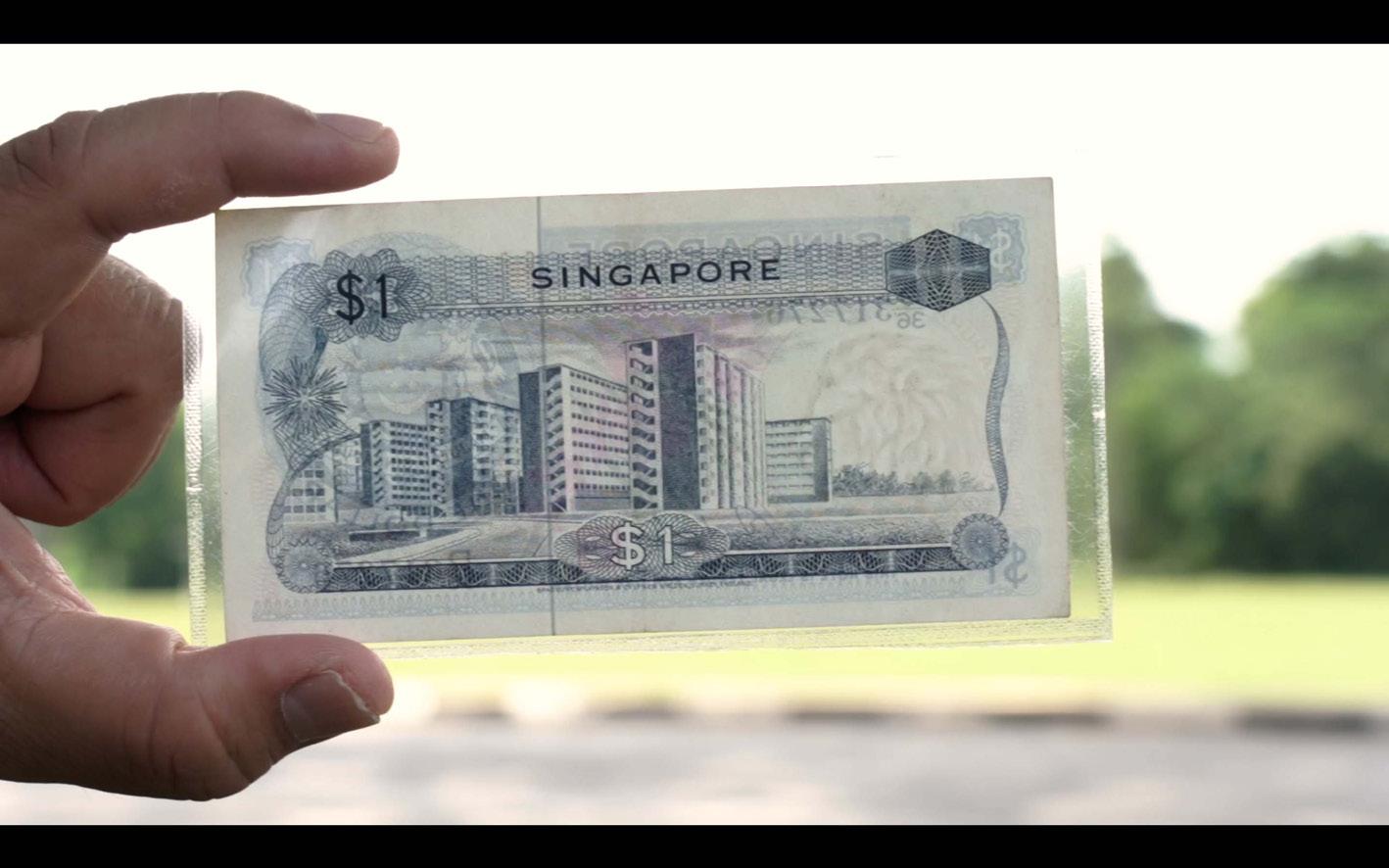
108
1$ Dollar note featuring Tanglin Halt. Courtesy of Jerome Lim.
Tanglin Halt is one of the frst public housing estates of independent Singapore, built in 1962. Te architecture of the buildings was so important that they were featured on the $1 notes. It was a modernist success story; a story of moving people from squatter communities into modern high-rises. It's also a story of trauma: in the so-called “squatter communities” there was, for sure, malaria and all sorts of diseases, but also a sense of community and continuity. Tis is a foundational, repeated trauma in Singapore of moving from the village community to the high-rise, and then, as these high-rises don’t last long, people continue to be moved around. Land speculation is intense. It keeps swapping hands, as much of the economy is built on the construction industry. In the end, Tanglin Halt held out longer than a lot of other places. Even though, in living memory, it is the second home for some of the older generation, Tanglin Halt was where they were living since the 1960s. Tat allowed for a ferce sense of ownership over the estate, which manifests also in the ecology around the estate and the land along the railway line. Afer Singapore’s independence, Malaysia still owned this strip of land – the railway and fve metres on each side, until 2011. Tis sort of informal zone, which is not Singapore nor strictly Malaysia, this sort of in-between zone, allows for a whole lot of informal-sector activity, some of it legal, some of it not so legal. And
109
also the shrines. Te oldest ones are Hindu. Tere was a wonderful syncretic development in Malaysia, Singapore, and Indonesia, where migrant Chinese agricultural people moved afer the revolution or even during the end of the Qing dynasty, at the end of the 19th century. Tey brought a Taoist animism, which is related to ecology. Tis congealed with an existing Malay world-engagement with spirits that can attach to a tree, a rock, or something which looks anthropo or zoomorphic. Tese spirits adopted by migrant Taoist communities were given the title of Datuk – meaning ‘person’, ‘sir’ – and Kong – meaning ‘grandfather’. People come to the Datuk Kong shrines and hang out, and they become a community. Tere were several of those along the rail tracks.
M: Tese were considered illegal, right?
L: Yes. Singapore has inherited from British colonial taxonomy a way of dividing the population according to three ofcial “races” –Chinese, Malay and Indian – which are printed on the national ID cards, alongside a fourth category “Others”. Tey also have a number of ofcial religions, like Buddhism, Hinduism, Islam, and Christianity. Tese ofcial religions have ofcial places of worship. But practices that are groundup, particularly when connected to the land, become suspicious. Tere's a continuous push
110
and pull with these shrines. I've seen one of the Datuk Kong shrines be knocked down twice.
M: And it keeps being rebuilt?
L: Yes. Tese displaced populations have maintained a ferce insistence on a connection to the land and shared spaces. All this ground-up investment in placemaking is constantly under threat but fnds its way to resist. Even when little farms get bulldozed, they move the farm a little bit further, and then a little bit further into the secondary jungle.
In Tanglin Halt, particularly the older generation felt comfortable in their eccentricity. For many, this freedom used to give the place its magic. Tis was also the case when we held the exhibition in the centre of Tanglin Halt. Te residents took over. Tese aunties – auntie, in SingaporeEnglish, is a respectful thing to say for a lady of a certain age ... I would be an auntie! – they would come along and say, “I think this sculpture is really ugly, I’m going to cut it a little bit.” Kids would bring their own birds to the exhibition, and because the projectors were indoors and warm, the birds would sit on them, and you couldn’t get them out. Tere was a club alongside the railway where people held competitions with doves making particular calls. All the dove owners would go and hang their
[Lucy laughs.]
111
bird cages and their little hammocks alongside the railway. Tere was so much happening there. Most of the conversations in the flm I had the luck to continue over many, many years. It’s something that builds up: a low-intensity layering.
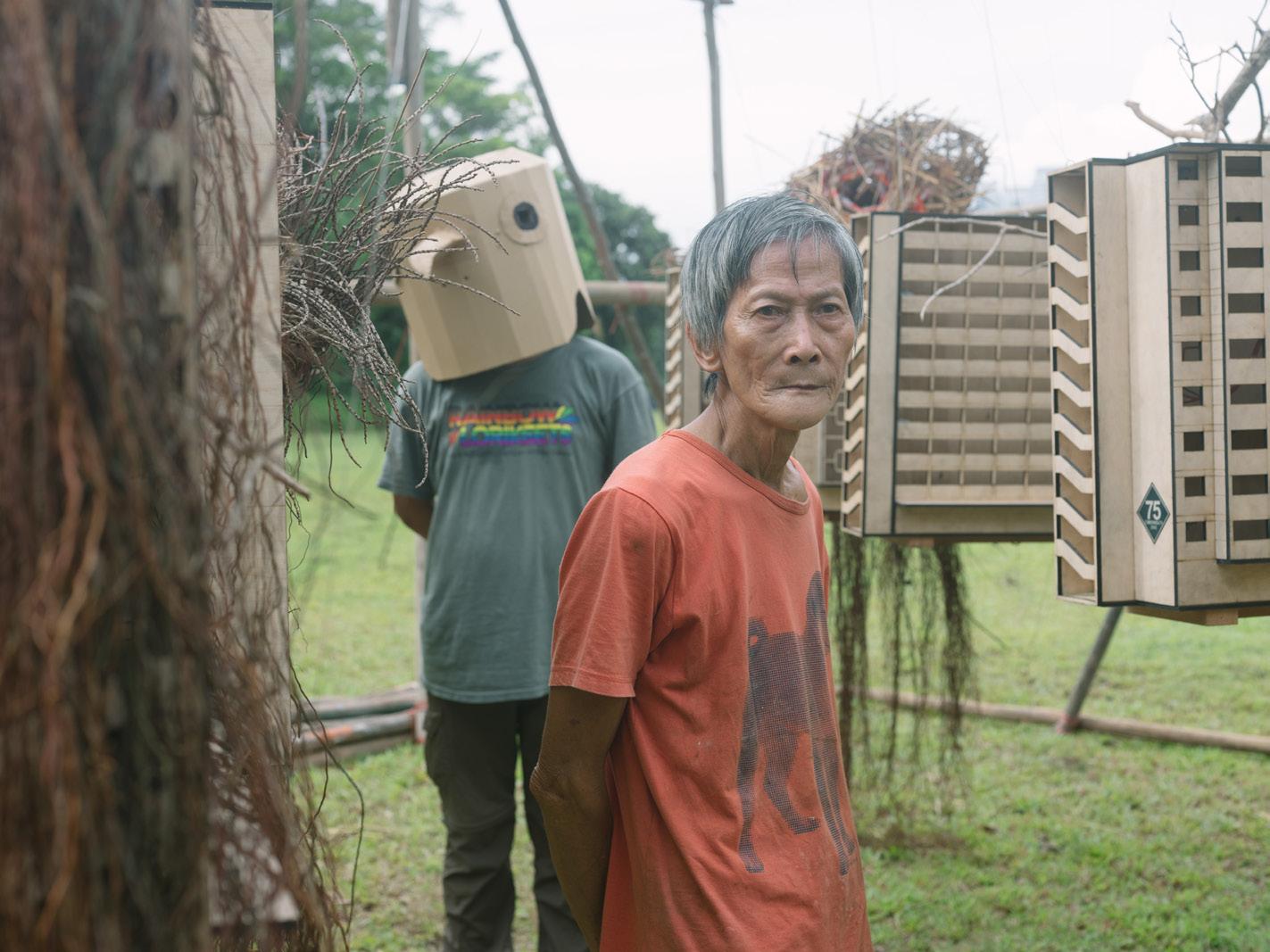
Mr Chua Thiam Seng and Ornithologist David Tan. Film still from {if your bait can sing the wild one will come} Like Shadows Through Leaves, 2021, by The Migrant Ecologies Project. 28 Minute 5.1 short flm. Conceptualised by Lucy Davis, together with: Sound Designer, Zai Tang, Cinematographer & Editor, Kee Ya Ting, Editor, Daniel Hui & Design Studio CROP Singapore.
112
M: It seems to me that each element of the project tried to build upon the previous, branching out and decentralising the artistic process. How have the locals and the project impacted one another?
L: I don’t formulate this as a community project because the artistic premises are mine and of the artists I work with. We were interested in community stories and voices, and the process was clearly curated. Having said that, such were the personalities we worked with that they ofen outperformed our interventions!
We produced interviews, songs, and recordings from schools. It wasn’t only the residents but activists and scientists were interviewed too. We decided to do thirty-two short flms with a bird call as the starting point. Te composition involved matching the voice tonality and the afective range of the conversation with the bird in question. For example, we had a hornbill with its raucous laughing call and an interview with an ornithologist with a really raucous voice. Tere was Esther who had nine free-fying parrots in her apartment and called herself parrot mother … Tat was a done deal! She was paired with a long-tailed parakeet.
M: Jumping back quickly, why do you think Tanglin Halt allowed people to be eccentric?
113
L: It's about time and the space. Te area along the tracks hadn’t been developed like the rest of Singapore because it was owned by Malaysia. You've got this green corridor going through the whole city, plus bits of secondary jungle that grew alongside it. It gave people access to continue practices they would have had in the kampung (the village). But it’s also a matter of time: ffy years in the same place, doing the same things.
M: In 2021, you’ve released the flm {if your bait can sing the wild one will come} Like Shadows Trough Leaves. 1 Te flm recollects your work in Tanglin Halt for over fve years. What is the relationship between the flm and the extended work you did in Tanglin Halt?
L: It was serendipitous that during the pandemic we got funding to produce audiovisual work rather than an exhibition.
M: You were directing from here [Helsinki], am I right?
L: Yes.
M: Tat’s another level of trust with your colleagues!
114

L: I mean, I think they wanted to kill me. Kee Ya Ting, a long term collaborator and former student, took over both the management and the cinematography. She was producing the wayang (outdoor theatre), and a whole lot of friends and people I didn’t even know agreed to help weave the nests. It was a collective thing. We made a little handbook on how not to pull up the plants, asking permission from the plant, fnding what the plant is ... you know, this respectful relation.
M: I have a question about nesting and housing, which I guess is about collective identity. I’ll quote two of the locals featured in the flm. One [Lucy laughs.]
115
Film still from {if your bait can sing the wild one will come} Like Shadows Through Leaves, 2021, by The Migrant Ecologies Project.
person refers to the sound of the train line “... every time (one) can hear the train, going come, going come, going come…” Later in the flm, another local mentions their relationship with the birds, “I fnd great joy to listen to the sounds (of the birds) and mimic them ... just sitting there and enjoying a little chat.” I think your flm succeeds in portraying a conversational landscape between humans, birds, vegetation, and urban infrastructures – and between their diferent housing: the functionalist housing, the bird nests, the soil covered by fallen leaves. Tese visual and sonic conversations imply a process of making a home with and for each other, which also negotiates a colonial past, a migratory life, and multi-racial and multi-species cohabitation.
L: It’s also about rhythm and repetition. We chose those utterances because there’s music in mimicking the train, “going come going come.” Another interviewee told me, “I remember when I frst moved to Tanglin Halt, I would see everybody come home at night and peep out of their house like pigeons.”
M: Te flm features only a few chosen locals and the cut-out silhouettes of the birds, which become representatives of a crowd of humans and birds that otherwise escape the camera. Yet, there’s a strong sense of growth: many sonic layers (interviews, spoken poetry, feld
116
recordings, bird callings) overlay, creating the sense of an overcrowded social life inside the residential buildings and the foliage of the trees. Tanglin Halt becomes the point of conversion, the host of many trajectories of life. Can you share how and why sound became such an important tool to narrate this place?
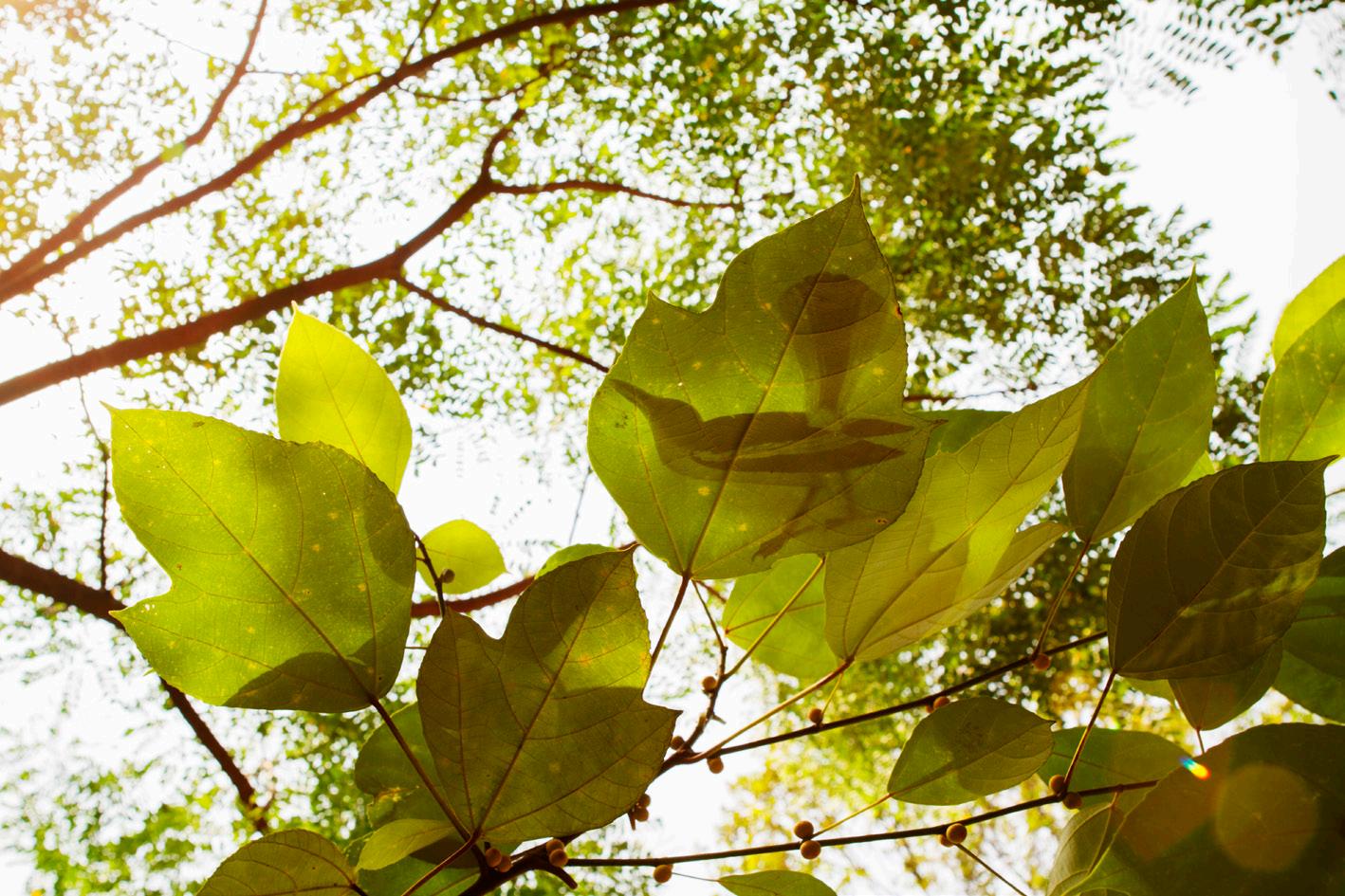
L: Let’s start with the politics of representation: not wanting to make a museological “treasure box” that captures these creatures, but having them absent and present at the same time. “Alluring” may be a helpful word to evoke the excess you’re talking about without imprisoning
117
Film still from {if your bait can sing the wild one will come} Like Shadows Through Leaves, 2021, by The Migrant Ecologies Project.
it within a predatorial perspective.
When it comes to sound ... When I moved to Tanglin Halt, I was drawn to a “bird zone”. I began to hear this one bird, the oriental magpie robin, again and again. Its persistence pierces your layer of consciousness. Once, I looked out and there were two guys carrying a female bird in a cage, trying to trap her. Later, I found that this magpie was trapped into near extinction in the 1970s for bird song competitions because they sing so beautifully, but it was now making a comeback along the railway. Tese guys were the vestiges of an old generation. A woman told me that it’s also a patriarchal thing: mirroring the relationship with their wives, they keep these treasures in cages. It opened an unresolved, contested knot of interests situated in this place and these birds. Tat’s what we wanted to show in the flm: not to resolve these knots but to reveal them.
M: Some friendships start like that, no? A person is so present in your horizon that they become a friendly call.
L: Absolutely. She [the bird] was an initiator.
M: To summarise, my perception of the flm is that it narrates a special nesting spot – Tanglin Halt – along a line of movement – the railroad –
118
and portrays their “magic”, also for the eye of an outsider or visitor. Shadows, transparencies, light, and soundscapes tell a slippery, unruly communal living while respecting the privacy of all its forms of life. Tey also symbolise a non-linear, “eccentric” history created through time, negotiating power dynamics, (enforced) movement, and borderlines. One of your collaborators comments on the highrise infrastructures against which birds crush and die: “Some migrants navigate by the stars, city lights make them crush into buildings.” It summarises so well the consequences of the politics of migration at large. In your experience, how can artistic work participate in battling border politics and the deadly, exclusionary geographies it creates?

119
L: Tat’s a big question. I guess this flm is the closest that the Migrant Ecologies Project has come to advocacy. In my imagination, there’s a politician who’ll see it and think, “Oh, maybe we should leave things alone once in a while.” Tat’s probably not going to happen ... But there is this wish in the flm and, I hope, productive grief work and salvage – I guess in Anna Tsing’s terms, that when things have been wrecked, there are still bits of magic, memories, and echoes which are living and can create something transformative. Grief work which does not entomb that which has gone, but which holds open the possibility that in this mulch of voices, something can hatch.
Mr Amin Koh sitting by the wayang. Film still from {if your bait can sing the wild one will come} Like Shadows Through Leaves, 2021, by The Migrant Ecologies Project.
120
^
1. {if your bait can sing the wild one will come} Like Shadows Trough Leaves, by Te Migrant Ecologies Project. 28 Minute 5.1 short flm
Conceptualised by Lucy Davis, together with: Sound Designer, Zai Tang, Cinematographer & Editor, Kee Ya Ting, Editor, Daniel Hui & Design Studio CROP Singapore (https://migrantecologies. org/Like-Shadows-Trough-Leaves)
121
122
Heads on a shared stomach
 Naomi and Wanda Holopainen
Naomi and Wanda Holopainen
123


Naomi Holopainen explores themes of existence, space, and time in her art. Her work contemplates cause and efect, necessity, and possibility. Recently, she has focused on unravelling threads that bind connections, the essence of freedom, exploring the interplay between dreams and realities, and challenging conventional notions. Her art prompts a reevaluation of bodily experiences.
Wanda Holopainen is an art activist, documentarian, and storyteller. Teir creative journey revolves around narratives, archives and memory. Trough their artistic endeavours, Wanda seeks to reimagine and unthink our world as we know it.
I frst encountered Naomi and Wanda’s work during URB Festival, 2023 at Kiasma Museum of Contemporary Art, in the exhibition curated by Kairos collective, and I have followed their work since. Tis conversation took place in a studio in Merihaka, Helsinki, on January 19, 2024.
124
Naomi (N)
Wanda (W)
Micol (M)
N: A goal our practices share is reshaping europatriarchal narratives by telling diferent stories and holding space for various realities to coexist.
W: For me, art is learning about myself. We are all artful, creative beings. “Active” stands for actively learning about the world and being curious about my surroundings. Te term “art activism” came from reading about Zanele Muholi; they’re one of my models. I was reading about their lens-based work, which really relates to what I want to do. Ofen here, in Finland, one defnes their practice through schooling, education, or work titles; for me, it's more about setting the intentions of what I'm working towards, directing my path. When thinking about who we are, through art one can try to work past identity describers that are colonial words like being Black or queer. It’s about saying “I am what I do,” letting my actions speak for who I am.
125

Naomi and Wanda Holopainen, installation What if exhibited as part of the 24th edition of URB festival program Kairos: a quiet storm. 2023, Kiasma Museum, Helsinki.
M: I understand. I really enjoyed your installation for A Quiet Storm, URB Festival 2023, with Kairos collective.1 We can start from there. Te installation featured Naomi’s sculptures and three screens with Wanda’s video and sound work. Te combination was inviting, textural, in an interesting and soothing way. Does this resonate with your intentions, Naomi?
N: For me, art is about the kind of conversations or environment one can build around it and how that holds people. I want to fnd ways to allow the material to tell a story and mould into what it wants to be. Tis approach is hard at times as it involves letting go of control and fnding where there’s friction and openings. To move and become one with your surroundings entails a wide search for what it means to be or feel connected. Above all, it’s a play. Finding myself happens best when I work with my hands, alone with my experiences, and get lost in it all.
126
M: How does working with certain materials relate to the idea of shifing narratives?
N: Because it’s hard to create something without contributing to the excess of this world, I’m working with lefovers to break the standard of what is art and what is käsityö – handicrafs.
Objects and materials have a story and a memory of their own. I search for what materials and symbols have meant in specifc contexts, various communities, and practices.

127
Naomi Holopainen, Making of the muuttolinnut, migratory bird.
W: You were working with seashells and looking into their mythology, their economy, and environmental impact; you put yourself into the diferent ways a material exists in the world. Ten you try to communicate with it, “What do you want to tell?” I would say that your piece came from the interaction with those elements in Ghana: the sand, the seashells. So you ended up creating this oceany object …
M: A seabed.
N: Yes. I work with memory to unpack the secrets my body carries. It helps recognise what emotion needs to emerge through the material. Te way I communicate with it, letting out and letting go, tells about where I am at. Ofen, the material is a mirror towards myself.
M: Speaking of memories, Wanda, your video work What if was beautiful. Te three screens worked well to reinforce the multiplication and divergence of images that memories are ofen made of. Can you say more about the process behind making the flm?
W: It’s the frst piece I've shown publicly, despite flming for a long time. I've been refecting on what has directed me towards working with the video camera. A big part of it has to do with not having a strong origin story, about my lineages,
128
my ancestors. Where do I come from? I've always looked for stories from other people. In the flm, I use the only cassette tape we have from our childhood when our mum's friend came to visit us from Switzerland and brought a video camera. It's nice to go back to that flm – this documented, captured piece of my memory – to hear myself and think, “Wow, that's how I was as a child!” I started to question how much of our memory is real when pieces blend together with time. And then, bringing the ‘what-if? story’, this alternative reality, into the picture too. More concretely, I created a story about what would happen if we had grown up in Ghana. I’ve come to use the three screens because I didn’t want the image to be something polarised, an either-or, but instead have some fuidity.
Wanda Holopainen, Film still from a three channel installation What if exhibited as part of the 24th edition of URB festival program Kairos: a quiet storm. 2023, Kiasma Museum, Helsinki.
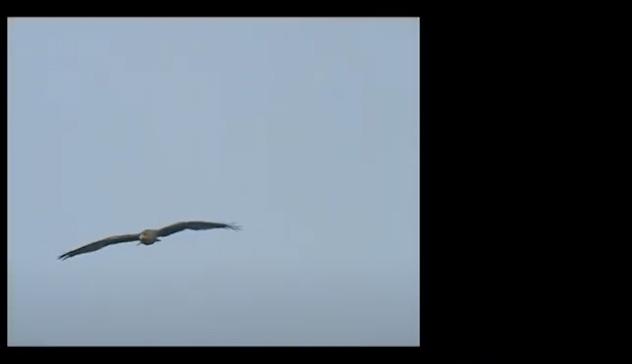
129
N: I’ve read in a book that forgiveness is letting go of a better past. Tis whole process was meaningful for us both to let go of what could have been if things were diferent.
M: Imperfection brings relatability. It creates a space where one can insert themselves as the viewer, participating in a feeling or a story rather than having it packaged for us.
W: Tat’s why I like to work with analogue flm; it has a texture, and it’s hard to keep the camera steady, so I enjoy playing with that imperfection. Having the physical copy of the cassettes led me into archiving and how archives tell histories. In modern Eurocentric thinking, something exists only if it's documented, whereas ofen in Africa,
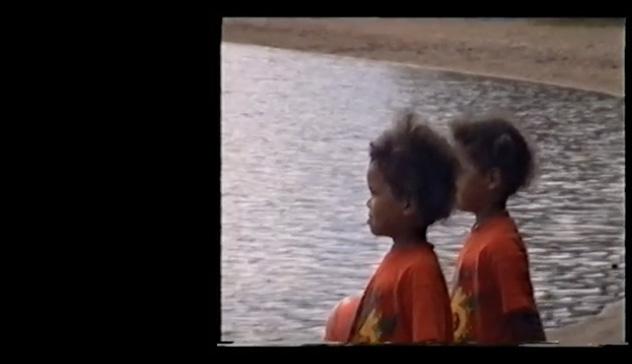
130
histories are oral. What I capture is mostly not for public view. I saw my friends doing amazing things; it felt like they were making history, and I needed to capture them because it was monumental. Watching the analogue material, I’ve heard them saying, “It’s like I'm looking at myself from the future!” It’s a way of encouraging people to recognise that what they do now shapes their future, blending these timelines together so we can see the impact of our actions, and at the same time recognising that I wouldn't be who I am without the people around me.
M: I think “portraiture” could be a good way of describing your practice, Wanda. It’s the kind of narrative that your camera work and editing create. Does it resonate with you?

Holopainen, Film still from ELEMENTS MINI BALL x Night at the Museum . organised by Roza Ahmad at the Cable Factory Museum. 21 April 2023. In the picture, Harmony 007.
131
Wanda
W: It’s about intimacy, about trust. Te analogue camera really imprints my decisions into the flm. For example, I wanted to flm the ice,
Wanda makes a cylinder with their hands and peaks an eye through them. and then, “Oh, nice light!”
Wanda quickly moves their imaginary camera up towards the ceiling. Naomi and I laugh.
While flming, I talk to people; they interact with me. Even though I don't feature directly, the relationship between me, them, and the space comes forth ... Portraiture?
N: Portretti.
W: I kind of like it! Talking about lens work, we have to consider the diferent kinds of gaze applied to diferent bodies. I want to go beyond how people look. I love to flm when people perform because that’s when the soul speaks through the body. I love it when I can capture someone's essence.
M: Maybe this brings us to collective work. What role does it play in your practice? I’m thinking about the diferent projects you’re involved in, for example, Kairos collective and IDA Radio.
132
W: I’m glad you’re mentioning this because I’ve been questioning how we defne community. Western thinking and worldviews are ofen binary: either the individual or the collective, but I believe they are intertwined. In Ghana, they have this crocodile with two heads on a shared stomach representing unity. I guess, as twins, we understand that everything we do as individuals also afects the other.
N: Tinking about the individual and the community as coexisting increases the responsibility we hold towards each other.

W: When it comes to productions like Among the Olive Groves at IDA Radio, I appreciate that these projects can bring people together around the same goal.2 It creates a space where we join because it’s meaningful work – whether or not we are friends or get along. In the end, you have this “We did it!” It creates a sense of ‘we’.
M: Te capacity to build collective work is maybe not synonymous with community – which can be a place of belonging that is also exclusive. I think this distinction can be very empowering when
133
Naomi Holopainen, Sculpture part of I once dreamed publication with TuoTuo.
it comes to work because it opens up resources for others beyond personal relationships and friendship, for example.
N: Or we could expand how we defne community!
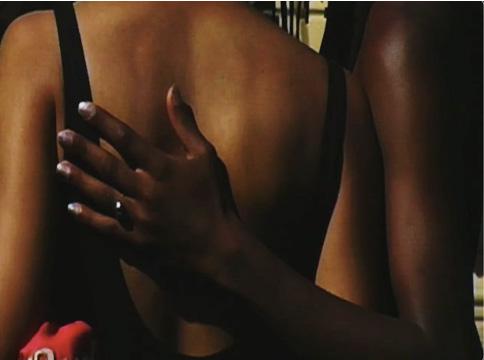
M: Speaking of afecting change, could you introduce what Atàa Agency is and how the project started?
N: We arrived from the States when Trump was elected, both having studied communication, carrying a certain view of what it means for a corporation to be involved in diferent communities. In the States, the understanding
134
Wanda Holopainen, flm still from Sonya Lindfors: common moves, collaborative artwork facilitated by Melissa Şimşek-Linsa. The Helsinki Biennial, 30 July 2023, Helsinki, Finland.
of marketing and the role of an institution is way diferent. Coming back to Finland, both of us had diferent issues with our own working lives …
W: We had to do something.
N: Te realities we knew from our background didn’t exist in many working environments, where people would recognise one reality only and push that into the world through marketing and communication. We started reaching out to companies about representation; they replied that they had no issues. Ten George Floyd was murdered, the Black Lives Matter movement grew, and conversations started to happen here in Finland too.
M: Companies would call you, then?
N: Tey would ask for training.
W: We educated ourselves on how to verbalise social issues. Speaking Finnish ourselves, it was maybe easier for people to accept other truths. We worked with creative agencies in content creation, production companies, and so forth.
N: Of course, organisational structures approached us without knowing what they really needed. “We want something related to diversity or inclusion”, while we’d have to tell them that
135
the issue is about power, values, the invisible models that set how knowledge is defned, who’s considered the expert, what’s perceived as worthy, what’s the sense of time within an organisation.

Wanda Holopainen, Film still from a self-organised demonstration at the Compass Square of Helsinki Railway station in which the protesters condemned the Finnish Defence Forces’ agreement to buy an anti aircraft system from Israel. 16 November 2023, Helsinki, Finland.
136
M: You were doing more work than them.
W: In a way, yes, or maybe more proactively. It’s frustrating because people want ready answers, but this work requires all of us to look deeply into ourselves.
M: And that takes time.
W: Tat’s why the business world is tiring to work with; timing is urgent, the machine is always moving, nobody has the time to stop.
N: It was still valuable. We had good conversations.
W: But we started questioning about, you know, Audre Lorde’s saying, ‘Te master’s tools will never dismantle the master’s house,’ about the time of urgency.3 We can’t host a workshop about social issues in a place that supports the conditions holding these issues in place. We’re asked to do knowledge production, but we can’t do it anymore in terms of rational, theory-based teaching. Putting that on hold, searching for what we are good at, led us into doing arts. We have plans for how to continue working in these diferent sectors – arts, grassroots organisations, education, the business world. Patiently, they’ll come alive.
137
1. Kairos: A Quiet Storm, URB 2023, Kiasma Museum of Contemporary Art Helsinki (https://kiasma.f/en/events/kairos-aquiet-storm/).
2. Among the Olive Groves, IDA Radio, 5 November 2023 (https:// idaidaida.net/shows/among-the-olive-groves).
3. Audre Lorde, ‘Te Master’s Tools Will Never Dismantle the Master’s House’, frst spoken at the Second Sex Conference, New York, 29 September 1979.
138
Subcontinental Helsinki
 Muniba Rasheed
Muniba Rasheed
139
Muniba Rasheed is a graphic designer based in Helsinki, Finland. She holds a Master’s in Visual Communication Design at Aalto University. Her practice focuses on publication design and looks into questions of identity, representation, and community.

Muniba:
While choosing a typeface is ofen considered a decision that only concerns graphic designers, the ripple efect of these choices is more signifcant than we realise. Te decisions made go on to shape and defne how our cities look and how the larger communities for whom we are designing are represented in the city’s wider landscape.
Subcontinental Helsinki (2023) investigates the image of the letterform in the context of subcontinental restaurants in Helsinki, Finland, and how they are used to perpetuate cultural stereotypes.
140
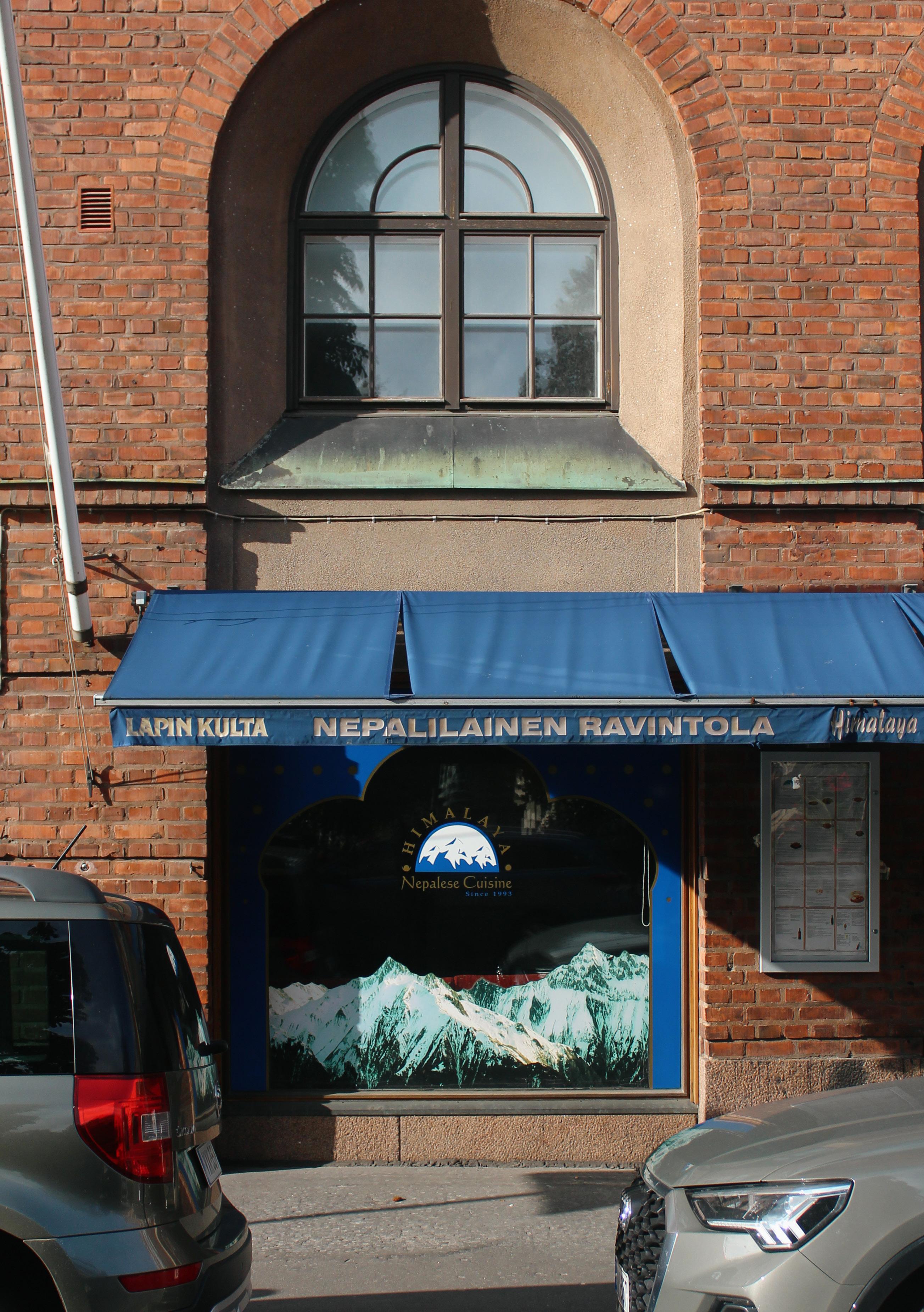

Muniba Rasheed, Sewa, Itämerenkatu, Ruoholahti, series ‘Subcontinental Helsinki’, 2023, digital photograph.
Muniba Rasheed, Himalaya, Ratakatu, Kaartinkaupunki, series ‘Subcontinental Helsinki’, 2023, digital photograph.
^ ^

143

144
Muniba Rasheed, Shahi Dera, Malmin asematie, Malmi, series
‘Subcontinental Helsinki’, 2023, digital photograph.

145
Muniba Rasheed, Ravintola Nepal, Kivenlahdenkatu, Kivenlahti, series ‘Subcontinental Helsinki’, 2023, digital photograph.

Muniba Rasheed, Ravintola Saba, Hämeentie, Sörnäinen, series
‘Subcontinental Helsinki’, 2023, digital photograph.
Tactile connection
 Alejandra Alarcón
Alejandra Alarcón
147

Alejandra Alarcón is a Mexican designer based in Helsinki, working at the intersection of art, design, and food. Her work blends personal narratives, research, and material exploration that take the form of artefacts, installations, and edible sculptures intended to be shared and eaten. Alejandra’s fascination with food, its meaning, signifcance, and aesthetic appreciation builds on her memories from home, where cooking is a meaningful process that requires patience and love. Alejandra’s food culture and nonculinary background in design allow her to create ephemeral edible works that merge with other materials, resulting in multisensory and immersive experiences of remembering the past or speculating about tomorrow.

I frst met Alejandra during her exhibition Queremos Pastel at Asbestos Art Space in the spring of 2023. Later that summer, Alejandra invited me to Aromas from Home, the event in the back garden of a private house in Kulosaari, part of her MA thesis and the ongoing project Edible Landscapes. Tis conversation took place on November 6, 2023, in Alejandra’s kitchen while cooking salsa.
148
Alejandra (A)
Micol (M)
A: Mum always reminds me that when I'm stressed, my stomach feels it.
M: It’s such an intense experience, what’s related to our guts.
Alejandra peels of some garlic and cleans the chillies.
M: When did you start working with food?
A: I've always been obsessed with food. When I was very young, I told mum I wanted to attend a local cooking school for kids. Instead, she forced me to learn all her recipes, “You don’t even know how to make rice!” I thought she might be right, that I wasn’t passionate enough to turn it into a career. Studying something related to art seemed a better option. During high school, I started baking cakes for my family and selling them to my classmates. People asked why they were so expensive. I was unmotivated.
I connect a lot with my parents through food. We’re opposites, but in the kitchen ... mum
149
and I always found a connection. My dad loves sobremesa [conversing with friends and family afer a meal] and could talk for hours.
At university, I noticed the connection between food and design. I remember reading anthropologist Tim Ingold describing soup as a material. I began to understand food diferently. Working in the chem-arts lab was like working in a kitchen. Everything can be related to food. It is another material that you can shape, mould, and arrange.
M: Do you have any particular relation to other materials beyond food?
A: With ceramics, the gestures are just like cooking. A tactile connection. On the other hand, food is extremely valuable. Is it adequate to play with food? How can we work with food and be conscious of its value?
M: You’re sketching a parallelism between design, art making, and cooking as practices one learns to master and through which value is added. Te fnal object becomes something else or other than the raw material.
150

Alejandra Alarcón, Queremos Pastel: A Sensuous Act of Remembrance, 2023. Asbestos Art Space, Helsinki. Photo by Radul Radulović.
A: It is about the hands that shape it. And food is a great material because it has always been here. One learns these skills (of cooking, of working with food) throughout life. In my hometown, it’s common to sell food if you need money. Maybe it doesn't happen here as much. Tings are more regulated. At home, women sell homemade cakes, and my mum would get angry because they all taste the same. Many taste artifcial, intense, and they would be cheaper to buy. It’s about trends.
151
M: What makes people resort to food as a means to sustain themselves economically?
A: My grandmother used to sell cakes when she was younger. My aunt also started a business to help support her family. My grandfather was a baker. My cousin sells ceviche ... Simply, the job is not enough, so one needs to fnd other ways to earn money.
M: Tis tension is interesting: between the standard, the everyday, and a sense of specifcity or uniqueness that relates identity to homemade recipes. Trough taste, we learn about goodness, genuinity, tradition.
A: It creates belonging to a certain way of doing things.
M: It might come down to how we eat. In my mind, food is inherently social ... It accrues less value if you don’t share it. Maybe it's about intimacy, about how close we allow others to ourselves. When you bake your cakes, and bring these favours to the plate, your recipes and memories, the relationship with your parents, you’re sharing a big part of yourself. Food that has been standardised is less intimate.
Alejandra proceeds to chop the onions.
152
A: Of course, cooking is an act of intimacy. For the installation Aromas from Home in Kulosaari this summer, I was scared that people wouldn’t like my mole. It was my culture I was sharing. On the other hand, with the cakes, I insert this extra layer: a format that is common and shared.
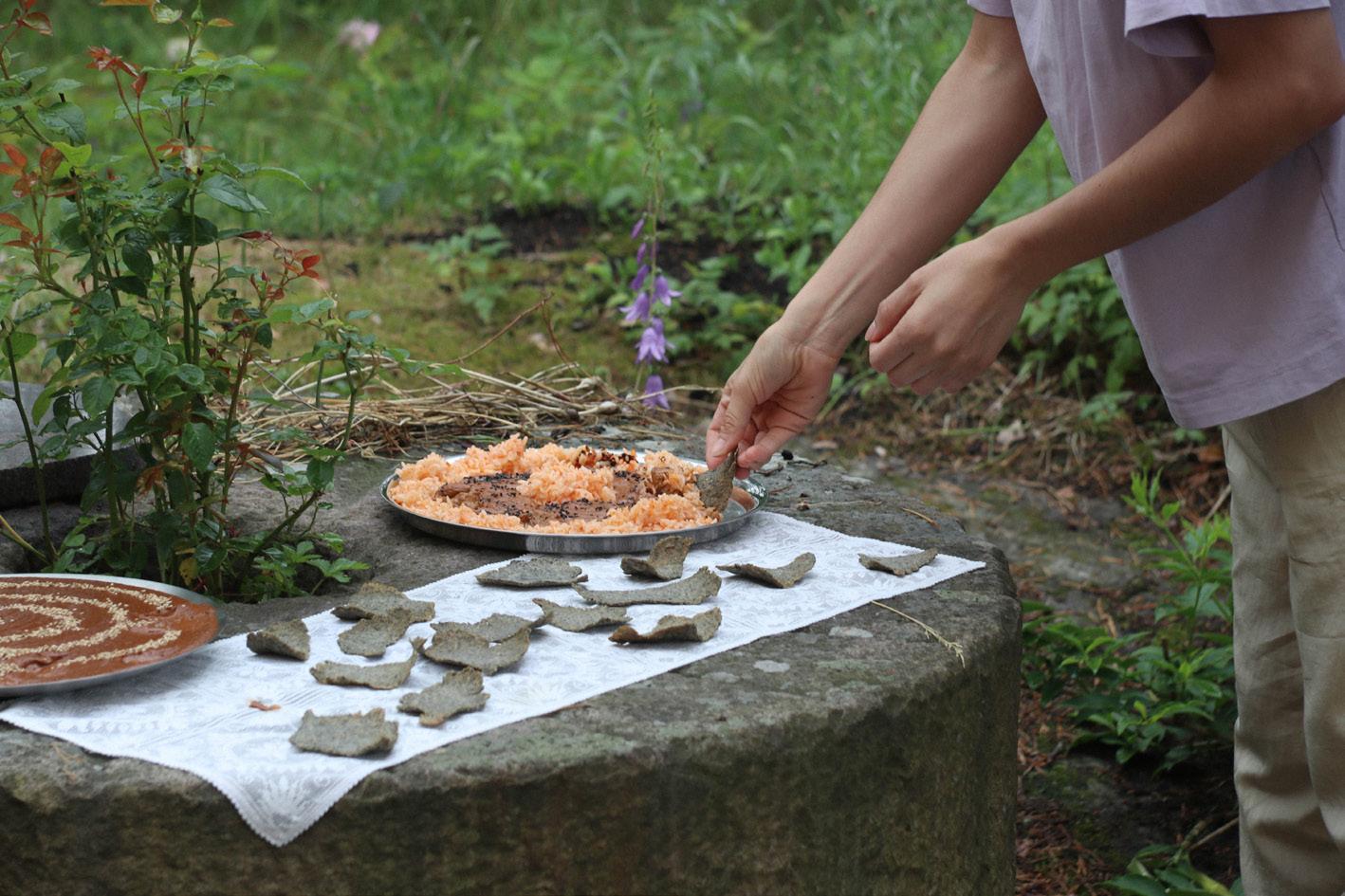
Alejandra Alarcón, mole and tostada for Aromas From Home: Cooking Memories Through Complex Salsas, 2023. Kulosaari garden, Helsinki. Photo by Radul Radulović.
M: So when you prepare the cakes, do you try to reach a “mediation point”, so to say, a “safer” taste? What would happen then if someone didn’t like the food?
153
A: It would be fne, too. Taste is very personal. I heard mixed opinions about my cakes, and I like that.
M: Tis goes back to the immediacy of the act of eating: for example, when food makes you sick. Ingesting food, there’s an extent to which one can’t help how they feel about it. Literally getting to one’s guts ignates strong reactions ... I can understand why it feels scary.
A: Every cake is an experiment. Tere’s always a little fear.
M: Te fear of encountering someone else?
A: Exactly. It also relates to the ephemeral quality of each installation.
M: So, I understand that the cakes are a safer battleground because you expect a level of familiarity from the visitors. What convinced you to cook other traditional Mexican food, like mole, for the installation in Kulosaari?
A: In my thesis research, I explored three ingredients: chilli, maize, and cakes. In the process, the question came up of why I make cakes, as people commented that they aren’t Mexican. But for me, they are, as much as they are part of many other cultures. From the point
154
of view of the ingredients, chocolate and vanilla are the base of my cakes, and they are Mexican ingredients. At the same time, they aren’t exclusive to a culture. Because of this, they are experienced diferently.
Alejandra roasts the chillies, onions, garlic, and two whole tomatoes in a hot pan.
M: What do you aim for when preparing the installations?
A: I want people to experience space through all the senses. I want them to be intrigued and curious. I always think about the space and people’s interactions, knowing that they will engage in conversations around the food. I want people to be present and mindful, even if the experience is ephemeral. Space defnitely plays a big role.
M: Does the space always come frst?
A: Yes, that’s how I plan it. I will prepare the food to match the space.
M: How do you approach the aesthetics of your food?
A: Each cake follows a concept, but my approach is mostly intuitive. Te aesthetic needs to rely on
155
what I have available, and I want everything to be edible. I aim for the cake to be perceived as a landscape, adding textures.

156
Alejandra Alarcón, detail of an edible landscape featured in the exhibition opening of Intento: A decolonial attempt by S.U.R. collective. 2023, Aalto University. Photo by Alejandra Alarcón.
M: I fnd their look pleasing and welcoming at once. Which is also the atmosphere of your events: this sense of easiness and everyday
A: Tis imperfection also goes against Western standards, for example, French cuisine. Te cakes are beautiful because it looks like a person has made them.
M: It also makes me think of expectations around cleanliness.
[Alejandra smiles.] beauty.
A: In the case of the exhibition in Asbestos, I was defnitely afraid of being a bad host. Ten, friends brought more friends; I met you. People told me it felt safe and that they could talk to anyone. Food became a starter for conversations.
M: Do you think that the gallery space hosted a diferent atmosphere than the back garden in Kulosaari?
157
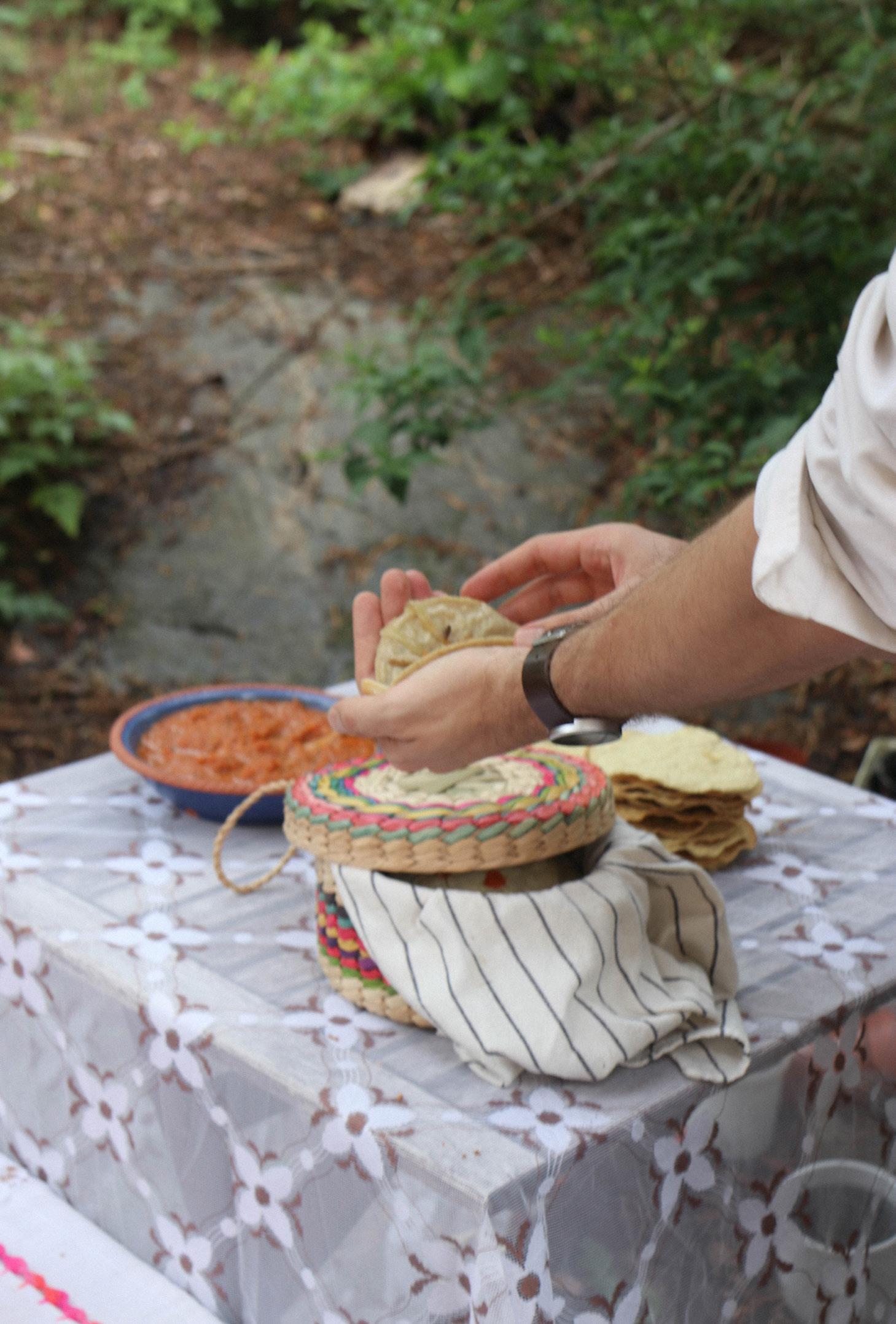
158
Alejandra Alarcón, Aromas From Home: Cooking Memories Through Complex Salsas, 2023. Kulosaari garden, Helsinki.
Photo by Radul Radulović.
A: In the gallery, I was the host, cutting and serving the cakes: this was the relationship between me and the visitors. In Kulosaari, I expected people to serve themselves and, as there were no plates and containers but your hands, the food itself served as a container. People ate less, and it slowed down the interaction with others and with the food itself.
M: Tose were the frst two times I experienced your installations. Te gallery space is a place I know, a space I’ve worked in, and it carries familiarity in terms of how I behave. Of course, this might be diferent for others. Yet, arriving in the gallery that day, I met you, a person I didn’t know, handing over food that had such a strong connection to your home, and that interaction felt particularly special and vulnerable. It came naturally to talk to strangers, eating from the same plate, trying each other’s cakes despite having just met. Tere was this bodily easiness. People sat on the foor. A certain way of behaving in the gallery had changed. In Kulosaari, instead, we were in someone’s house, and paradoxically, I felt more self-aware, while at the same time, I was expected to act with more autonomy. So while the gallery space could become anyone’s place, in that specifc instance, your friend’s back garden felt even more intimate. Tis intimacy puts more responsibility on us as guests – and I don’t mean it in a negative sense. Maybe it comes
159
down to a “technical” diference between being visitors and guests. In the exhibition space, you can come and leave; being in someone’s house took a diferent weight.

A: Something else I noticed was that people who might not be used to the gallery space seemed shy to ask for more food. Not only so, but they wouldn’t serve themselves afer being served by me. Tey would come to ask for permission. Te music performance, for example, aimed at
160
Alejandra Alarcón, Queremos Pastel: A Sensuous Act of Remembrance, 2023. Asbestos Art Space, Helsinki. Photo by Radul Radulović.
making the space more welcoming. I loved that people sat down and stayed. Tey appropriated the space. In Kulosaari, I, too, was more intimidated ... Well, I’ve loved getting to know new people through food.
M: We haven’t stopped talking about relationships today, from your mum to strangers. Food always sits somewhere in-between personal and private space.
M: What’s the next step?
A: To blend.
M: Why do you call the cakes Landscapes?
A: I’ve always been interested in how landscape is perceived, especially through photography. I understand the landscape not only as a broader concept that people visualise but as every thing. Walking around Helsinki, I collect leaves and write about these found objects. Te leaf itself becomes a landscape.
M: So you’re looking at diferent scales of place, and imply that place is constituted by the assemblage of its things.
Alejandra puts the blent salsa back into the pot on the hob.
161
M: What is the relationship between the design elements in your work, like the carved table in Exquisite Disaster of Eating, and the participatory part of your events? Can you already envision a future development for those?
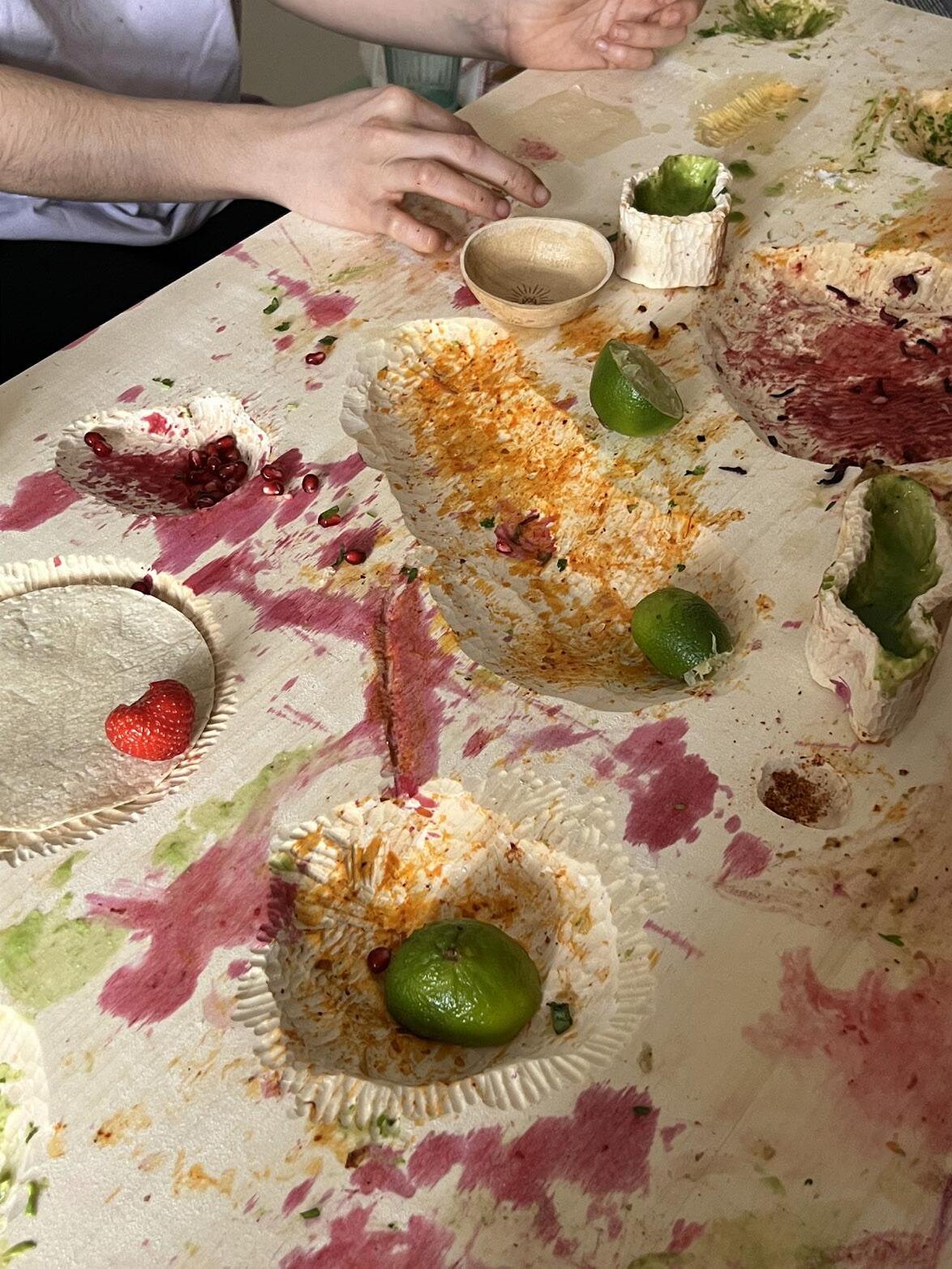
162
Alejandra Alarcón, The Exquisite Disaster of Eating. A food performance with Mexican food on a hand-carved wooden table, 2022. Photo by Alejandra Alarcón.

163
Alejandra Alarcón, The Exquisite Disaster of Eating. A food performance with Mexican food on a hand-carved wooden table, 2022. Photo by Alejandra Alarcón.
A: Te table was born out of an experiment with containers and how they relate to our hands. Recently, I’ve worked on some bowls. Tey are inspired by memories from Mexico, the large earthenware mum cooks in every Sunday when she has the whole family over. I play with these images, for example, in the case of the ears [the handles] of this pot.
She hands over a shallow handmade bowl held by four loops with opposite inclinations.
M: Tere’s something lovely and playful about this one. It is again about how we hold and handle it.
A: In Kulosaari, I invited people to write short notes about the experience, and someone commented on the sound that earthenware makes when you scrape food of with metal cutlery and how it awakened memories from their childhood. It’s especially important that I can design these objects myself.
M: Tey function as bodily extensions. Te table, for example, choreographs the guests’ movements.
A: Yes, people interacting with the table of Exquisite Disaster of Eating and how the colours
164
of the food stained the wood and traced their movements was very interesting.
We pour the salsa into one of Alejandra’s clay pots glazed in brown and purple.
A: I want to keep exploring how people interact with food, especially when I don’t mediate or host that process. I want to work more with seasonal ingredients and forage. I’m now going back to Mexico, I’m excited to cook with mum. I’ve interviewed her for my thesis: for her and grandma, most of their life is spent in the kitchen. Of course, this has to do with gender and labour, but also with empowerment. Selling food is a form of self-empowerment.
M: And also, maybe, it is about how much space one can take by sharing their food with others.
A: Yes, I love this idea. [Alejandra smiles.]
Alejandra and I sit across the table, her bowl between us. We spoon the salsa out, one tortilla at a time, while the other hand runs afer it to catch any drip from staining the tablecloth.
165
166
A Resistance Against Abundant Comfort
 Amy Gelera, S.U.R.
Amy Gelera, S.U.R.
167

Amy Gelera (she/they) is a Visual Communication Designer originally from Guatemala City, based in Helsinki. Troughout their academic life, they have studied in various parts of Europe and completed their studies in Visual Communication Design (MA) at Aalto University. Tey are a co-originator and board member of decolonizing collective S.U.R. Teir independent visual practice revolves around social dialogues concerning discrimination and decolonization–protest, irony, and humour are key elements of their critical approach.
168
Comfort
Discomfort has caused a lot of movement in my life; discomfort kicked me into diferent diasporas, brought me to Finland, and ultimately pushed me away from home. In a constant shif of geographies, bureaucracies, and self-defnitions, I found myself dizzy. Restless and with the need to lay down, I was longing for relief. In Finland, I believed I had found the comfort I was searching for, but that same comfort made me uncomfortable in other ways.
Te university, my frst touching point in Finland, seemed a contemporary educational haven within a progressive social democracy. At the time, it appeared to me as a good gate into future comfort. Naturally, as the months passed and a pandemic evolved, my perspective continued to mutate. I understood many uncomfortable realities and acquired comfortable privileges. It was within this institution that I was introduced to intersectionality and critical design practices, and continued to develop an interest in these.
169
I was then uncomfortable identifying the many questions of progress and technocratic problem-solving inside the university, constantly overlooking the consequences, histories, and geographies of current exploitative systems and oncoming futures.
By now, I have not found the type of comfort I yearned for so long, and I do not desire it anymore.
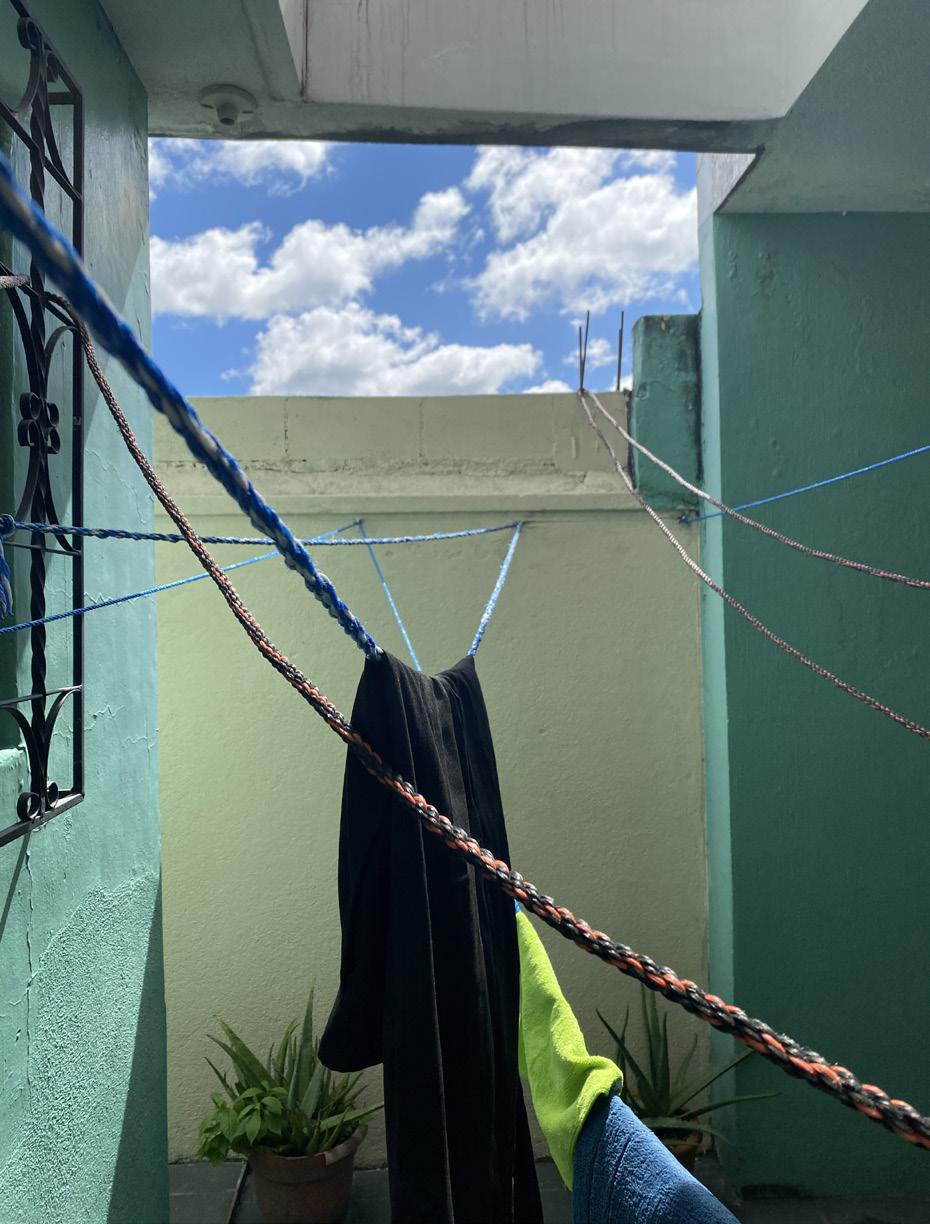
170
Amy Gelera, Picture of my grandmother’s house’s inner yard.
Abundance
For comfort, one needs abundance, in whichever sense of the word. Abundance of peace, abundance of education, abundance of resources or abundance of access. Te West has defned comfort by acquiring abundance through the exploitation of resources. Te comfort that much of Europe is reluctant to criticize inherently depends on making others uncomfortable by extracting much of their abundance. With time, my body has understood that an immigrant status is a bureaucratic method to make many lives uncomfortable when trying to chase the abundance missing from our territories.
“Within the mountains that enclose the valley of Guatemala City (fg. 1), I was born and nurtured. Guatemala, like most of Latin America, currently fnds itself entangled in a complicated postcolonial web–struggling between the dominance of faith, the need for political and cultural revolution and the overbearing nature of neoliberalism. Tis urban infusion exposes its citizens to the realities of acculturation–we are consequently assigned
171
a perception that yields and skews beneath the pressure of western ideals. Living in the metropolis of an exploited less developed country provides an environment that exposes how the afermath of colonialism systematically constructs a dystopian mess in the neoliberal sphere.”1
Te quote above is the frst paragraph of my MA thesis, Te Cyber West Manifested in the Corporeal Rest, submitted in 2022 at Aalto University. Te critique of comfort and abundance from an immigrant perspective still tends to be received with much resistance and dismissed as invalid even when that critique comes from a privileged place. We have seen the extraction of our abundance and where it has been relocated – the comfortable are reluctant to listen to these uncomfortable truths.
172
Amy Gelera, Pages of The Cyber West Manifested in the Corporeal Rest, 2022, MA thesis in Visual Communication Design, Aalto University.
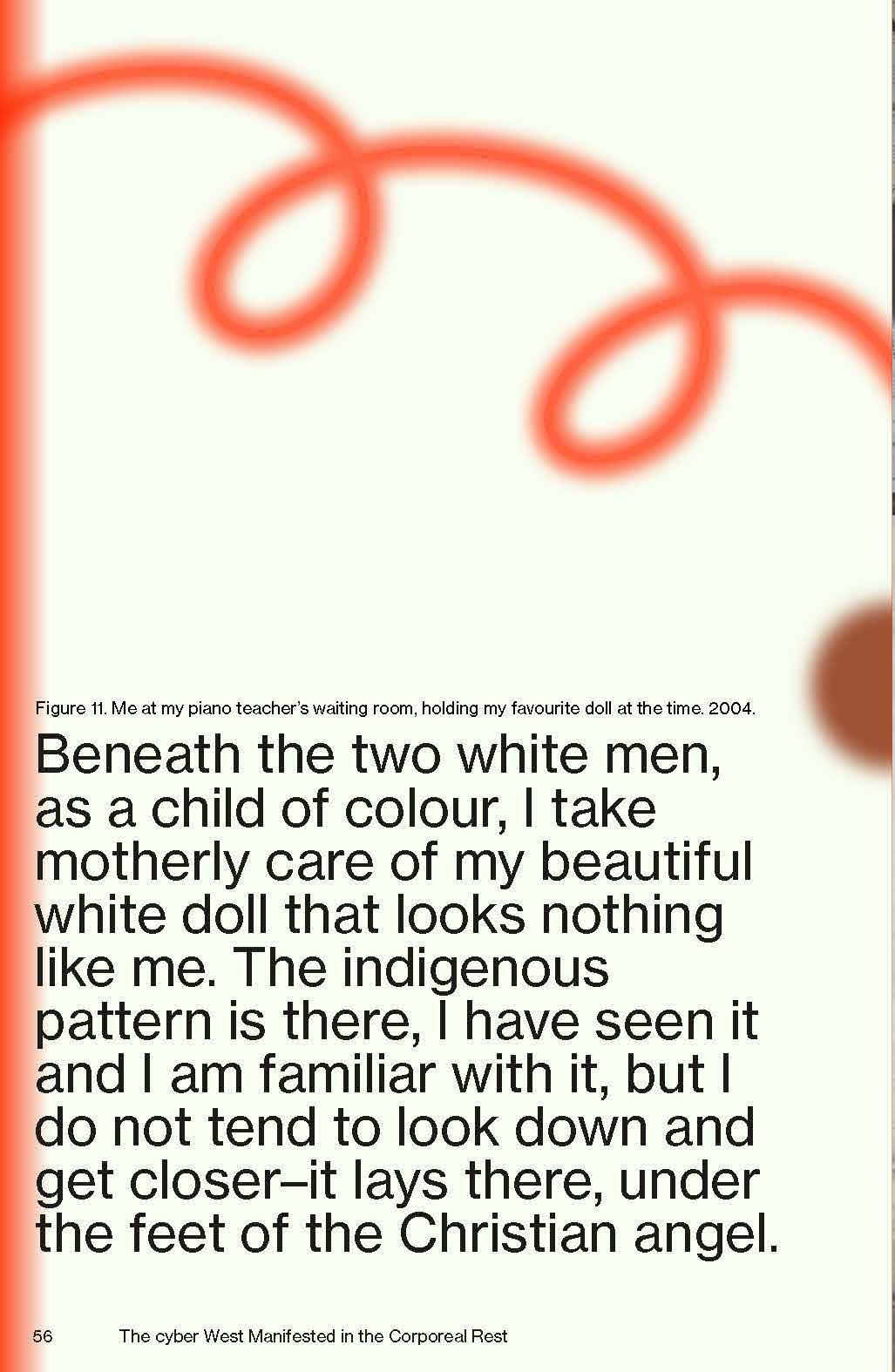
173

174
Resistance
I believe that the discomfort that has constantly propelled so many of us to move and make does not ofen resist well against comfort – most of us do not wish to continue to struggle perpetually, we must also have the opportunity to laze and recover. It is very uncomfortable to face the possible comfort that a country can achieve supported by colonial histories and structures that facilitate the exploitative extraction of abundances in countries of the Global South, like the territories I come from. Resisting abundant comfort does not require much when one does not inherit it by privilege, but creating a critique against it requires organizing. Trough collaborative resistance, discomfort, and abundance, S.U.R. was born and with it our manifesto:
“We are an essentially Latin-American collective. We are an apapacho. We are an intersectional and eco-feminist presence. We are contradiction. We are an attempt to decolonize the spaces of knowledge creation. We are an experiment, in constant
175
construction and re-signifying. We are dialogue and protest. We are threads of an expanding quilt. We are salt fats, mountain ranges and rivers. We are cuerpas in action.”2
Resistance is urgent within educational institutions that do not open the dialogue to alternative critical perspectives of current ways of making and thinking that perpetuate biassed and violent technologies and knowledges. Resisting requires making abundant comfort uncomfortable and discomfort comforting. S.U.R. collectively decided to comfort each other by acting and caring through the discomfort of the south. Many of us do not have the privilege to comfortably ignore the violent fght for abundance in our territories. Instead, we have used our discomfort as a moving force against comfortable narratives pushed around and towards us.
I ofen think about how quickly we adapt to discomfort once it becomes part of our lives and how much it hurts once comfort gets taken away. How only when we are uncomfortable, we are prompted to move. How when we move, we look beyond our own. For me, moving is resistance.
176
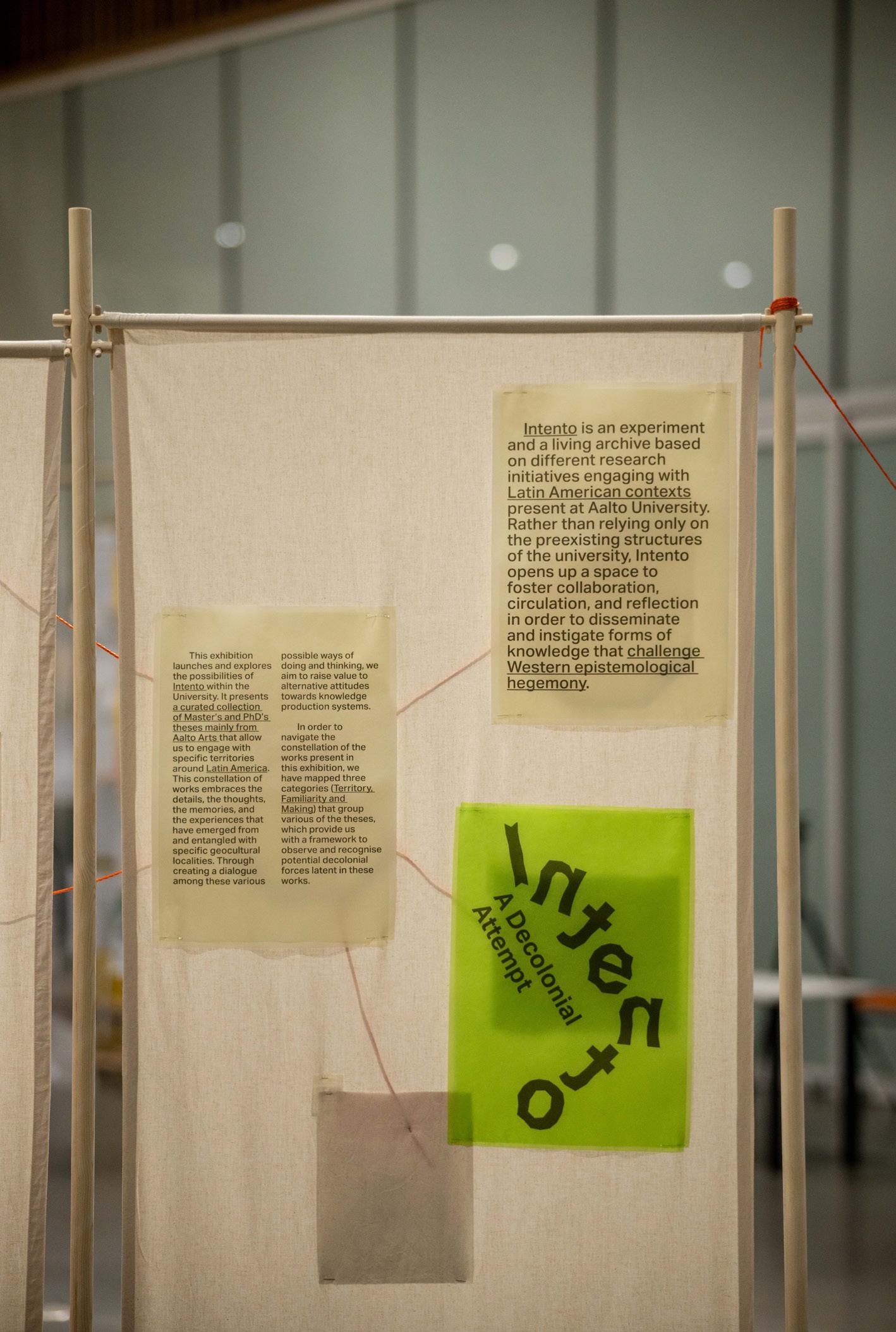
177
1. Amy Gelera, Te Cyber West Manifested in the Corporeal Rest, MA thesis, Department of Art & Media, Visual Communication Design Programme, Aalto University, Finland, 2022 (https:// thecyberwest.cargo.site/).
2. S.U.R. Manifesto (https://somos-sur.org/).
S.U.R., Panel of Intento’s exhibition structure, installation design in collaboration with YouTellMe Collective. Aalto University, Väre building, 18 October - 1 November 2023.
178
^
On Design
Lù Chén

Lù Chén is a designer and new media artist, born in Fuzhou, who has moved from Singapore to Helsinki. From the tropics to the Nordics, Lù grew up encountering boundaries as well as the distinctions they imply and the connections that exist across them. Trough both research and practice, Lù examines and challenges binaries like “native/ foreign,” “public/personal,” “West/non-West,” “masculine/feminine,” “human/non-human,” “artistic/ engineering” – so as to investigate the possibility of creating just and polyphonic futures by telling alternative stories together.

Layout work is a work with borders. To layout, we set up the margins, gutters, bleeds, and other guides to bind the text and images within these borders, yet sometimes we let them fow over the lines.
In the introduction to the book, ‘Nooks, Tresholds, and Highways’, Micol too refects on the dynamics brought about by lines. And here, you can see a variety of lines hopping around among the conversations, writings, and images. Sometimes they indicate the existence of a preset border, sometimes they suggest, “Let’s break it!”
I extracted these lines from OpenStreetMap, a free and open-access geographic database maintained via open collaboration. Te maps used refect the geographic locations related to each chapter: the city center of Helsinki, the shore of Eiraranta, Tanglin Halt in Singapore, the Sámi Museum Siida in Inari, sometimes a landscape that exists only in our minds – the traces to the Indian subcontinent embedded within Helsinki. From this atlas, we see the shipping lanes as dashed lines on oceans or creeks, the dense train lines extending from Helsinki Central Railway Station, or the nine-by-nine grid on these two pages – the skeleton of Fuzhou’s early urban planning since 221 BC.
We take on a journey with this bundle of maps. Between pages, I applied a gradient to let some light leak through an imagined crack on this border. In Here, Not., I wish that by playing with the ambiguity of dividing lines, I have managed to depict the energetic fows within the conversations and writings.
Tanks to Alejandra, Alice, Amy, Daniela, Eliisa, Francesca, Lotta, Lucy, Mercedes, Muniba, Naomi, Paola, Wanda, and Yes, for taking the time to dance, cook, walk, talk, and think with me. Tanks to Lù Chén for beautifully designing this book. Tanks to Nastia Svarevska for proofreading. Tanks to Patrizia Costantin, Programme Director of the Masters in Art & Media at Aalto University, for her continued support throughout my studies. Tanks to ViCCA staf and students, my colleagues, and my friends whose company has been so fundamental to the learning and growth that informs much of this book.
Here, Not. is part of Micol Curatolo’s research in the MA Visual Cultures, Curating and Contemporary Art at Aalto University, Finland.
Supported by Aalto ARTS
Text copyright Ⓒ the editor and authors
181
Here, Not. investigates how people express identity and belonging through contemporary arts and culture in the urban spaces of Helsinki.

Border thinking helps us refect on how cultural work participates, everyday, in the global and local dynamics through which we produce geographies that are accessible, safe, and home for some and not for others. In the book, these refections develop together with fourteen arts and cultural workers based in Helsinki. Teir contributions focus on what is happening across and beyond the threshold of the art gallery, how art sits and is bridged into the city.
ISBN 978-952-65469-0-2
ISBN 978-952-65469-1-9




 Micol Curatolo
Micol Curatolo

 Francesca Bogani Amadori
Francesca Bogani Amadori










 Lotta Hagelin, Biret-Iŋgá, Noticed, series ‘Museum Property’, 2023, digital photograph.
Lotta Hagelin, Biret-Iŋgá, Noticed, series ‘Museum Property’, 2023, digital photograph.
 Lotta Hagelin, Helmi, Spotted, series ‘Museum Property’, 2023, digital photograph.
Lotta Hagelin, Helmi, Spotted, series ‘Museum Property’, 2023, digital photograph.




















































